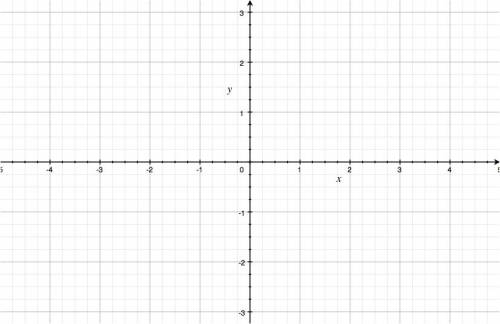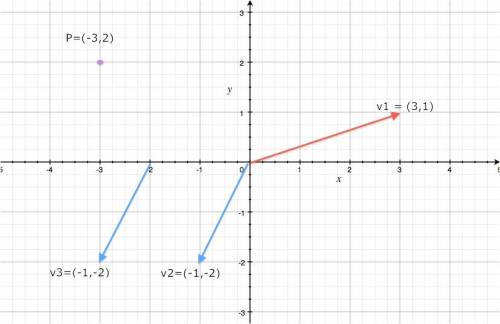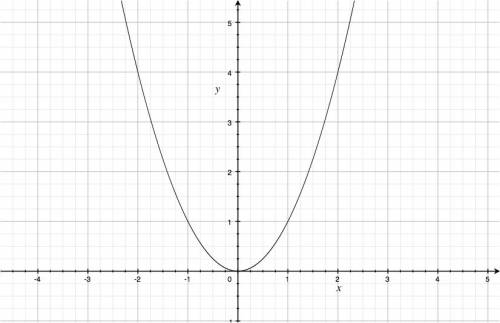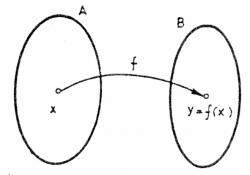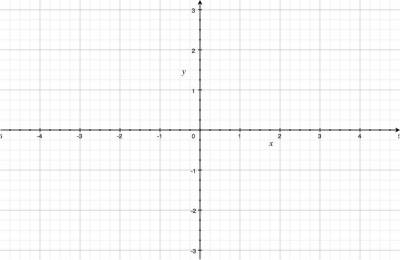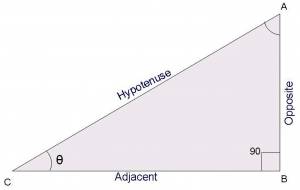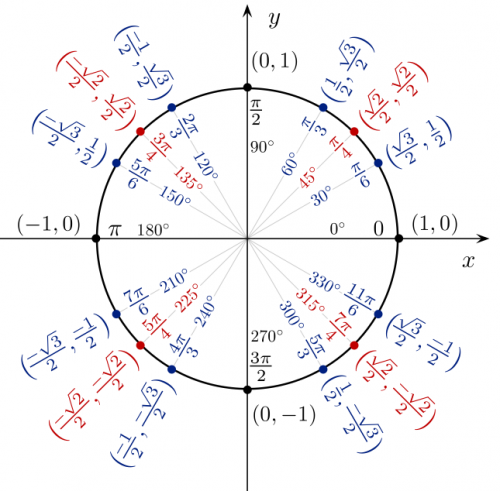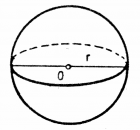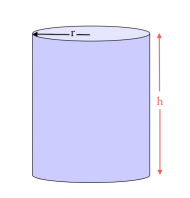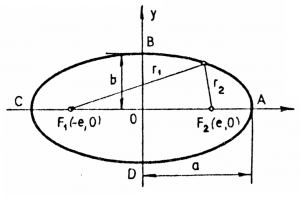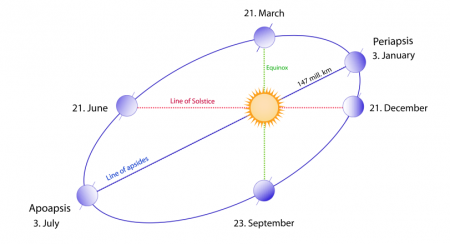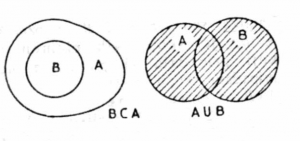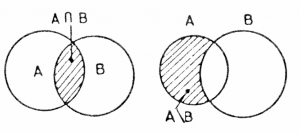The page you are reading is part of a draft (v2.0) of the "No bullshit guide to math and physics."
The text has since gone through many edits and is now available in print and electronic format. The current edition of the book is v4.0, which is a substantial improvement in terms of content and language (I hired a professional editor) from the draft version.
I'm leaving the old wiki content up for the time being, but I highly engourage you to check out the finished book. You can check out an extended preview here (PDF, 106 pages, 5MB).
Solving equations
Most math skills boil down to being able to manipulate and solve equations. To solve an equation means to find the value of the unknown in the equation.
Check this shit out: \[ x^2-4=45. \]
To solve the above equation is to answer the question “What is $x$?” More precisely, we want to find the number which can take the place of $x$ in the equation so that the equality holds. In other words, we are asking \[ \text{"Which number times itself minus four gives 45?"} \]
That is quite a mouthful don't you think? To remedy this verbosity, mathematicians often use specialized mathematical symbols. The problem is that the specialized symbols used by mathematicians are confuse people. Sometimes even the simplest concepts are inaccessible if you don't know what the symbols mean.
What are your feelings about math, dear reader? Are you afraid of it? Do you have anxiety attacks because you think it will be too difficult for you? Chill! Relax my brothers and sisters. There is nothing to it. Nobody can magically guess what the solution is immediately. You have to break the problem down into simpler steps.
To find $x$, we can manipulate the original equation until we transform it to a different equation (as true as the first) that looks like this: \[ x= just \ some \ numbers. \]
That's what it means to solve. The equation is solved because you could type the numbers on the right hand side of the equation into a calculator and get the exact value of $x$.
To get $x$, all you have to do is make the right manipulations on the original equation to get it to the final form. The only requirement is that the manipulations you make transform one true equation into another true equation.
Before we continue our discussion, let us take the time to clarify what the equality symbol $=$ means. It means that all that is to the left of $=$ is equal to all that is to the right of $=$. To keep this equality statement true, you have to do everything that you want to do to the left side also to the right side.
In our example from earlier, the first simplifying step will be to add the number four to both sides of the equation: \[ x^2-4 +4 =45 +4, \] which simplifies to \[ x^2 =49. \] You must agree that the expression looks simpler now. How did I know to do this operation? I was trying to “undo” the effects of the operation $-4$. We undo an operation by applying its inverse. In the case where the operation is subtraction of some amount, the inverse operation is the addition of the same amount.
Now we are getting closer to our goal, namely to isolate $x$ on one side of the equation and have just numbers on the other side. What is the next step? Well if you know about functions and their inverses, then you would know that the inverse of $x^2$ ($x$ squared) is to take the square root $\sqrt{ }$ like this: \[ \sqrt{x^2} = \sqrt{49}. \] Notice that I applied the inverse operation on both sides of the equation. If we don't do the same thing on both sides we would be breaking the equality!
We are done now, since we have isolated $x$ with just numbers on the other side: \[ x = \pm 7. \]
What is up with the $\pm$ symbol? It means that both $x=7$ and $x=-7$ satisfy the above equation. Seven squared is 49, and so is $(-7)^2 = 49$ because two negatives cancel out.
If you feel comfortable with the notions of high school math and you could have solved the equation $x^2-4=25$ on your own, then you should consider skipping ahead to Chapter 2. If on the other hand you are wondering how the squiggle killed the power two, then this chapter is for you! In the next sections we will review all the essential concepts from high school math which you will need for the rest of the book. First let me tell you about the different kinds of numbers.
Numbers
We will start the exposition like a philosophy paper and define precisely what we are going to be talking about. At the beginning of all matters we have to define the players in the world of math: numbers.
Definitions
Numbers are the basic objects which you can type into a calculator and which you use to calculate things. Mathematicians like to classify the different kinds of number-like objects into sets:
- The Naturals: $\mathbb{N} = \{0,1,2,3,4,5,6,7, \ldots \}$,
- The Integers: $\mathbb{Z} = \{\ldots, -3,-2,-1,0,1,2,3 , \ldots \}$,
- The Rationals: $\mathbb{Q} = \{-1,0,0.125,1,1.5, \frac{5}{3}, \frac{22}{7}, \ldots \} $,
- The Reals: $\mathbb{R} = \{-1,0,1,e,\pi, -1.539..,\ 4.94.., \ \ldots \}$,
- The Complex numbers: $\mathbb{C} = \{ -1, 0, 1, i, 1+i, 2+3i, \ldots \}$.
These categories of numbers should be somewhat familiar to you. Think of them as neat classification labels for everything that you would normally call a number. Each item in the above list is a set. A set is a collection of items of the same kind. Each collection has a name and a precise definition. We don't need to go into the details of sets and set notation for our purposes, but you have to be aware of the different categories. Note also that each of the sets in the above list contains all the sets above it.
Why do you need so many different sets of numbers? The answer is partly historical and partly mathematical. Each of the set of numbers is associated with more and more advanced mathematical problems.
The simplest kind of numbers are the natural numbers $\mathbb{N}$, which are sufficient for all your math needs if all you are going to do is count things. How many goats? Five goats here and six goats there so the total is 11. The sum of any two natural numbers is also a natural number.
However, as soon as you start to use subtraction (the inverse operation of addition), you start to run into negative numbers, which are numbers outside of the set of natural numbers. If the only mathematical operations you will ever use are addition and subtraction then the set of integers $\mathbb{Z} = \{ \ldots, -2, -1, 0, 1, 2, \ldots \}$ would be sufficient. Think about it. Any integer plus or minus any other integer is still an integer.
You can do a lot of interesting math with integers. There is an entire field in math called number theory which deals with integers. However, if you restrict yourself to integers you would be limiting yourself somewhat. You can't use the notion of 2.5 goats for example. You would get totally confused by the menu at Rotisserie Romados which offers $\frac{1}{4}$ of a chicken.
If you want to use division in your mathematical calculations then you will need the rationals $\mathbb{Q}$. The rationals are the set of quotients of two integers: \[ \mathbb{Q} = \{ \text{ all } z \text{ such that } z=\frac{x}{y}, x \text{ is in } \mathbb{Z}, y \text{ is in } \mathbb{N}, y \neq 0 \}. \] You can add, subtract, multiply and divide rational numbers and the result will always be a rational number. However even rationals are not enough for all of math!
In geometry, we can obtain quantities like $\sqrt{2}$ (the diagonal of a square with side 1) and $\pi$ (the ratio between a circle's circumference and its diameter) which are irrational. There are no integers $x$ and $y$ such that $\sqrt{2}=\frac{x}{y}$, therefore, $\sqrt{2}$ is not part of $\mathbb{Q}$. We say that $\sqrt{2}$ is irrational. An irrational number has an infinitely long decimal expansion. For example, $\pi = 3.1415926535897931..$ where the dots indicate that the decimal expansion of $\pi$ continues all the way to infinity.
If you add the irrational numbers to the rationals you get all the useful numbers, which we call the set of real numbers $\mathbb{R}$. The set $\mathbb{R}$ contains the integers, the fractions $\mathbb{Q}$, as well as irrational numbers like $\sqrt{2}=1.4142135..$. You will see that using the reals you can compute pretty much anything you want. From here on in the text, if I say number I will mean an element of the set of real numbers $\mathbb{R}$.
The only thing you can't do with the reals is take the square root of a negative number—you need the complex numbers for that. We defer the discussion on $\mathbb{C}$ until Chapter 3.
Operations on numbers
Addition
You can add and subtract numbers. I will assume you are familiar with this kind of stuff. \[ 2+5=7,\ 45+56=101,\ 65-66=-1,\ 9999 + 1 = 10000,\ \ldots \]
The visual way to think of addition is the number line. Adding numbers is like adding sticks together: the resulting stick has length equal to the sum of the two constituent sticks.
Addition is commutative, which means that $a+b=b+a$. It is also associative, which means that if you have a long summation like $a+b+c$ you can compute it in any order $(a+b)+c$ or $a+(b+c)$ and you will get the same answer.
Subtraction is the inverse operation of addition.
Multiplication
You can also multiply numbers together. \[ ab = \underbrace{a+a+\cdots+a}_{b \ times}=\underbrace{b+b+\cdots+b}_{a \ times}. \] Note that multiplication can be defined in terms of repeated addition.
The visual way to think about multiplication is through the concept of area. The area of a rectangle of base $a$ and height $b$ is equal to $ab$. A rectangle which has height equal to its base is a square, so this why we call $aa=a^2$ “$a$ squared.”
Multiplication of numbers is also commutative $ab=ba$, and associative $abc=(ab)c=a(bc)$. In modern notation, no special symbol is used to denote multiplication; we simply put the two factors next to each other and say that the multiplication is implicit. Some other ways to denote multiplication are $a\cdot b$, $a\times b$ and, on computer systems, $a*b$.
Division
Division is the inverse of multiplication. \[ a/b = \frac{a}{b} = \text{ one } b^{th} \text{ of } a. \] Whatever $a$ is, you need to divide it into $b$ equal pieces and take one such piece. Some texts denote division by $a\div b$.
Note that you cannot divide by $0$. Try it on your
calculator or computer. It will say error divide by zero,
because it simply doesn't make sense.
What would it mean to divide something into zero equal pieces?
Exponentiation
Very often you have to multiply things together many times. We call that exponentiation and denote that with a superscript: \[ a^b = \underbrace{aaa\cdots a}_{b\ times}. \]
We can also have negative exponents. The negative in the exponent does not mean “subtract”, but rather “divide by”: \[ a^{-b}=\frac{1}{a^b}=\frac{1}{\underbrace{aaa\cdots a}_{b\ times}}. \]
An exponent which is a fraction means that it is some sort of square-root-like operation: \[ a^{\frac{1}{2}} \equiv \sqrt{a} \equiv \sqrt[2]{a}, \qquad a^{\frac{1}{3}} \equiv \sqrt[3]{a}, \qquad a^{\frac{1}{4}} \equiv \sqrt[4]{a} = a^{\frac{1}{2}\frac{1}{2}}=\left(a^{\frac{1}{2}}\right)^{\frac{1}{2}} = \sqrt{\sqrt{a}}. \] Square root $\sqrt{x}$ is the inverse operation of $x^2$. Similarly, for any $n$ we define the function $\sqrt[n]{x}$ (the $n$th root of $x$) to be the inverse function of $x^n$.
It is worth clarifying what “taking the $n$th root” means and what this operation can be used for. The $n$th root of $a$ is a number which, when multiplied together $n$ times, will give $a$. So for example a cube root satisfies \[ \sqrt[3]{a} \sqrt[3]{a} \sqrt[3]{a} = \left( \sqrt[3]{a} \right)^3 = a = \sqrt[3]{a^3}. \] Do you see now why $\sqrt[3]{x}$ and $x^3$ are inverse operations?
The fractional exponent notation makes the meaning of roots much more explicit: \[ \sqrt[n]{a} \equiv a^{\frac{1}{n}}, \] which means that $n$th root is equal to one $n$th of a number with respect to multiplication. Thus, if we want the whole number, we have to multiply the number $a^{\frac{1}{n}}$ times itself $n$ times: \[ \underbrace{a^{\frac{1}{n}}a^{\frac{1}{n}}a^{\frac{1}{n}}a^{\frac{1}{n}} \cdots a^{\frac{1}{n}}a^{\frac{1}{n}}}_{n\ times} = \left(a^{\frac{1}{n}}\right)^n = a^{\frac{n}{n}} = a^1 = a. \] The $n$-fold product of $\frac{1}{n}$ fractional exponents of any number products the number with exponent one, therefore the inverse operation of $\sqrt[n]{x}$ is $x^n$.
The commutative law of multiplication $ab=ba$ implies that we can see any fraction $\frac{a}{b}$ in two different ways $\frac{a}{b}=a\frac{1}{b}=\frac{1}{b}a$. First we multiply by $a$ and then divide the result by $b$, or first we divide by $b$ and then we multiply the result by $a$. This means that when we have a fraction in the exponent, we can write the answer in two equivalent ways: \[ a^{\frac{2}{3} }=\sqrt[3]{a^2} = (\sqrt[3]{a})^2, \qquad a^{-\frac{1}{2}}=\frac{1}{a^{\frac{1}{2}}} = \frac{1}{\sqrt{a}}, \qquad a^{\frac{m}{n}} = \left(\sqrt[n]{a}\right)^m = \sqrt[n]{a^m}. \]
Make sure the above notation makes sense to you. As an exercises try to compute $5^{\frac{4}{3}}$ on your calculator, and check that you get around 8.54987973.. as an answer.
Operator precedence
There is a standard convention for the order in which mathematical operations have to be performed. The three basic operations have the following precedence:
- Exponents and roots.
- Products and divisions.
- Additions and subtractions.
This means that the expression $5\times3^2+13$ is interpreted as “first take the square of $3$, then multiply by $5$ and then add $13$.” If you want the operations to be carried out in a different order, say you wanted to multiply $5$ times $3$ first and then take the square you should use parentheses: $(5\times 3)^2 + 13$, which now shows that the square acts on $(5 \times 3)$ as a whole and not on $3$ alone.
Other operations
We can define all kinds of operations on numbers. The above three are special since they have a very simple intuitive feel to them, but we can define arbitrary transformations on numbers. We call those functions. Before we learn about functions, let us talk about variables first.
Variables
In math we use a lot of variables, which are placeholder names for any number or unknown.
Example
Your friend has some weirdly shaped shooter glasses and you can't quite tell if it is 25[ml] of vodka in there or 50[ml] or somewhere in between. Since you can't say how much booze there is in each shot glass we will say there was $x$[ml] in there. So how much alcohol did you drink over the whole evening? Say you had three shots then you drank $3x$[ml] of vodka. If you want to take it one step further, you can say that you drank $n$ shots then the total amount of alcohol you drank is $nx$[ml].
As you see, variables allow us to talk about quantities without knowing the details. This is abstraction and is very powerful stuff: it allows you to get drunk without knowing how drunk exactly!
Variable names
There are common naming patterns for variables:
- $x$: general name for the unknown in equations. Also used to denote the input to a function
and the position in physics problems.
- $v$: velocity.
- $\theta,\varphi$: the Greek letters “theta” and “phi” are often used to denote angles.
- $x_i,x_f$: Denote initial and final position in physics problems.
- $X$: A random variable in probability theory.
- $C$: Costs in business along with $P$ profit, and $R$ revenues.
Variable substitution
We often need to “change variables” and replace some unknown variable with another. For example, say you don't feel comfortable with square roots. Every time you see a square root, you freak out and you find yourself on an exam trying to solve for $x$ in the following: \[ \frac{6}{5 - \sqrt{x}} = \sqrt{x}. \] Needless to say that you are freaking out big time! Substitution can help with your root phobia. You just write down “Let $u=\sqrt{x}$” and then you are allowed to rewrite the equation in terms of $u$: \[ \frac{6}{5 - u} = u, \] which contains no square roots.
The next step when trying to solve for $u$ is to undo the fraction by multiplying both sides of the equation by $(5-u)$ to obtain: \[ 6 = u(5-u) = 5u - u^2. \] This can be rewritten as a quadratic equation $u^2-5u+6=(u-2)(u-3)=0$ for which $u_1=2$ and $u_2=3$ are the solutions. The last step is to convert our $u$-answers into $x$-answers by using $u=\sqrt{x}$, which is equivalent to $x = u^2$. The final answers are $x=2^2=4$ and $x=3^2=9$. You should try plugging these values of $x$ into the original equation with the square root to verify that they satisfy the equation.
Compact notation
Symbolic manipulation is very powerful, because it allows you to manage complexity. Say you are solving a physics problem in which you are told the mass of an object is $m=140$[kg]. If there are many steps in the calculation, would you rather use the number $140$[kg] in each step, or the shorter variable $m$? It is much better to use the variable $m$ throughout your calculation, and only substitute the value $140$[kg] in the last step when you are computing the final answer.
Functions and their inverses
As we saw in the section on solving equations, the ability to “undo” functions is a key skill to have when solving equations.
Example
Suppose you have to solve for $x$ in the equation \[ f(x) = c. \] where $f$ is some function and $c$ is some constant. Our goal is to isolate $x$ on one side of the equation but there is the function $f$ standing in our way.
The way to get rid of $f$ is to apply the inverse function (denoted $f^{-1}$) which will “undo” the effects of $f$. We find that: \[ f^{-1}\!\left( f(x) \right) = x = f^{-1}\left( c \right). \] By definition the inverse function $f^{-1}$ does the opposite of what the function $f$ does so together they cancel each other out. We have $f^{-1}(f(x))=x$ for any number $x$.
Provided everything is kosher (the function $f^{-1}$ must be defined for the input $c$), the manipulation we made above was valid and we have obtained the answer $x=f^{-1}( c)$.
\[ \ \]
Note the new notation for denoting the function inverse $f^{-1}$ that we introduced in the above example. This notation is borrowed from the notion of “inverse number”. Multiplication by the number $d^{-1}$ is the inverse operation of multiplication by the number $d$: $d^{-1}dx=1x=x$. In the case of functions, however, the negative one exponent does not mean the inverse number $\frac{1}{f(x)}=(f(x))^{-1}$ but functions inverse, i.e., the number $f^{-1}(y)$ is equal to the number $x$ such that $f(x)=y$.
You have to be careful because sometimes the applying the inverse leads to multiple solutions. For example, the function $f(x)=x^2$ maps two input values ($x$ and $-x$) to the same output value $x^2=f(x)=f(-x)$. The inverse function of $f(x)=x^2$ is $f^{-1}(x)=\sqrt{x}$, but both $x=+\sqrt{c}$ and $x=-\sqrt{c}$ would be solutions to the equation $x^2=c$. A shorthand notation to indicate the solutions for this equation is $x=\pm c$.
Formulas
Here is a list of common functions and their inverses:
\[ \begin{align*} \textrm{function } f(x) & \ \Leftrightarrow \ \ \textrm{inverse } f^{-1}(x) \nl x+2 & \ \Leftrightarrow \ \ x-2 \nl 2x & \ \Leftrightarrow \ \ \frac{1}{2}x \nl -x & \ \Leftrightarrow \ \ -x \nl x^2 & \ \Leftrightarrow \ \ \pm\sqrt{x} \nl 2^x & \ \Leftrightarrow \ \ \log_{2}(x) \nl 3x+5 & \ \Leftrightarrow \ \ \frac{1}{3}(x-5) \nl a^x & \ \Leftrightarrow \ \ \log_a(x) \nl \exp(x)=e^x & \ \Leftrightarrow \ \ \ln(x)=\log_e(x) \nl \sin(x) & \ \Leftrightarrow \ \ \arcsin(x)=\sin^{-1}(x) \nl \cos(x) & \ \Leftrightarrow \ \ \arccos(x)=\cos^{-1}(x) \end{align*} \]
The function-inverse relationship is reflexive. This means that if you see a function on one side of the above table (no matter which), then its inverse is on the opposite side.
Example
Let's say your teacher doesn't like you and right away on the first day of classes, he gives you a serious equation and wants you to find $x$: \[ \log_5\left(3 + \sqrt{6\sqrt{x}-7} \right) = 34+\sin(5.5)-\Psi(1). \] Do you see now what I meant when I said that the teacher doesn't like you?
First note that it doesn't matter what $\Psi$ is, since $x$ is on the other side of the equation. We can just keep copying $\Psi(1)$ from line to line and throw the ball back to the teacher in the end: “My answer is in terms of your variables dude. You have to figure out what the hell $\Psi$ is since you brought it up in the first place.” The same goes with $\sin(5.5)$. If you don't have a calculator, don't worry about it. We will just keep the expression $\sin(5.5)$ instead of trying to find its numerical value. In general, you should try to work with variables as much as possible and leave the numerical computations for the last step.
OK, enough beating about the bush. Let's just find $x$ and get it over with! On the right side of the equation, we have the sum of a bunch of terms and no $x$ in them so we will just leave them as they are. On the left-hand side, the outer most function is a logarithm base $5$. Cool. No problem. Looking in the table of inverse functions we find that the exponential function is the inverse of the logarithm: $a^x \Leftrightarrow \log_a(x)$. To get rid of the $\log_5$ we must apply the exponential function base five to both sides: \[ 5^{ \log_5\left(3 + \sqrt{6\sqrt{x}-7} \right) } = 5^{ 34+\sin(5.5)-\Psi(1) }, \] which simplifies to: \[ 3 + \sqrt{6\sqrt{x}-7} = 5^{ 34+\sin(5.5)-\Psi(1) }, \] since $5^x$ canceled the $\log_5 x$.
From here on it is going to be like if Bruce Lee walked into a place with lots of bad guys. Addition of $3$ is undone by subtracting $3$ on both sides: \[ \sqrt{6\sqrt{x}-7} = 5^{ 34+\sin(5.5)-\Psi(1) } - 3. \] To undo a square root you take the square \[ 6\sqrt{x}-7 = \left(5^{ 34+\sin(5.5)-\Psi(1) } - 3\right)^2. \] Add $7$ to both sides \[ 6\sqrt{x} = \left(5^{ 34+\sin(5.5)-\Psi(1) } - 3\right)^2+7. \] Divide by $6$: \[ \sqrt{x} = \frac{1}{6}\left(\left(5^{ 34+\sin(5.5)-\Psi(1) } - 3\right)^2+7\right), \] and then we square again to get the final answer: \[ \begin{align*} x &= \left[\frac{1}{6}\left(\left(5^{ 34+\sin(5.5)-\Psi(1) } - 3\right)^2+7\right) \right]^2. \end{align*} \]
Did you see what I was doing in each step? Next time a function stands in your way, hit it with its inverse, so that it knows not to ever challenge you again.
Discussion
The recipe I have outlined above is not universal. Sometimes $x$ isn't alone on one side. Sometimes $x$ appears in several places in the same equation so can't just work your way towards $x$ as shown above. You need other techniques for solving equations like that.
The bad news is that there is no general formula for solving complicated equations. The good news is that the above technique of “digging towards $x$” is sufficient for 80% of what you are going to be doing. You can get another 15% if you learn how to solve the quadratic equation: \[ ax^2 +bx + c = 0. \]
Solving third order equations $ax^3+bx^2+cx+d=0$ with pen and paper is also possible, but at this point you really might as well start using a computer to solve for the unknown(s).
There are all kinds of other equations which you can learn how to solve: equations with multiple variables, equations with logarithms, equations with exponentials, and equations with trigonometric functions. The principle of digging towards the unknown and applying the function inverse is very important so be sure to practice it.
Basic rules of algebra
It's important for you to know the general rules for manipulating numbers and variables (algebra) so we will do a little refresher on these concepts to make sure you feel comfortable on that front. We will also review some important algebra tricks like factoring and completing the square which are useful when solving equations.
When an expression contains multiple things added together, we call those things terms. Furthermore, terms are usually composed of many things multiplied together. If we can write a number $x$ as $x=abc$, we say that $x$ factors into $a$, $b$ and $c$. We call $a$, $b$ and $c$ the factors of $x$.
Given any four numbers $a,b,c$ and $d$, we can use the following algebra properties:
- Associative property: $a+b+c=(a+b)+c=a+(b+c)$ and $abc=(ab)c=a(bc)$.
- Commutative property: $a+b=b+a$ and $ab=ba$.
- Distributive property: $a(b+c)=ab+ac$.
We use the distributive property every time we expand a bracket. For example $a(b+c+d)=ab + ac + ad$. The opposite operation of expanding is called factoring and consists of taking out the common parts of an expression to the front of a bracket: $ac+ac = a(b+c)$. We will discuss both of these operations in this section and illustrate what they are used for.
Expanding brackets
The distributive property is useful when you are dealing with polynomials: \[ (x+3)(x+2)=x(x+2) + 3(x+2)= x^2 +x2 +3x + 6. \] We can now use the commutative property on the second term $x2=2x$, and then combine the two $x$ terms into a single one to obtain \[ (x+3)(x+2)= x^2 + 5x + 6. \]
This calculation shown above happens so often that it is good idea to see it in more abstract form: \[ (x+a)(x+b) = x(x+b) + a(x+b) = x^2 + (a+b)x + ab. \] The product of two linear terms (expressions of the form $x+?$) is equal to a quadratic expression. Furthermore, observe that the middle term on the right-hand side contains the sum of the two constants on the left-hand side while the third term contains the their product.
It is a very common for people to get this wrong and write down false equations like $(x+a)(x+b)=x^2+ab$ or $(x+a)(x+b)=x^2+a+b$ or some variation of the above. You will never make such a mistake if you keep in mind the distributive property and expand the expression using a step-by-step approach. As a second example, consider the slightly more complicated algebraic expression and its expansion: \[ \begin{align*} (x+a)(bx^2+cx+d) &= x(bx^2+cx+d) + a(bx^2+cx+d) \nl &= bx^3+cx^2+dx + abx^2 +acx +ad \nl &= bx^3+ (c+ab)x^2+(d+ac)x +ad. \end{align*} \] Note how we grouped together all the terms which contain $x^2$ in one term and all the terms which contain $x$ in a second term. This is a common pattern when dealing with expressions which contain different powers of $x$.
Example
Suppose we are asked to solve for $t$ in the following equation \[ 7(3 + 4t) = 11(6t - 4). \] The unknown $t$ appears on both sides of the equation so it is not immediately obvious how to proceed.
To solve for $t$ in the above equation, we have to bring all the $t$ terms to one side and all the constant terms to the other side. The first step towards this goal is to expand the two brackets to obtain \[ 21 + 28t = 66t - 44. \] Now we move things around to get all the $t$s on the right-hand side and all the constants on the left-hand side \[ 21 + 44 = 66t - 28t. \] We see that $t$ is contained in both terms on the right-hand side so we can rewrite the equation as \[ 21 + 44 = (66 - 28)t. \] The answer is now obvious $t = \frac{21 + 44}{66 - 28} = \frac{65}{38}$.
Factoring
Factoring means to take out some common part in a complicated expression so as to make it more compact. Suppose you are given the expression $6x^2y + 15x$ and you are asked to simplify it by “taking out” common factors. The expression has two terms and when we split each terms into it constituent factors we obtain: \[ 6x^2y + 15x = (3)(2)(x)(x)y + (5)(3)x. \] We see that the factors $x$ and $3$ appear in both terms. This means we can factor them out to the front like this: \[ 6x^2y + 15x = 3x(2xy+5). \] The expression on the right is easier to read than the expression on the right since it shows that the $3x$ part is common to both terms.
Here is another example of where factoring can help us simplify an expression: \[ 2x^2y + 2x + 4x = 2x(xy+1+2) = 2x(xy+3). \]
Quadratic factoring
When dealing with a quadratic function, it is often useful to rewrite it as a product of two factors. Suppose you are given the quadratic function $f(x)=x^2-5x+6$ and asked to describe its properties. What are the roots of this function, i.e., for what values of $x$ is this function equal to zero? For which values of $x$ is the function positive and for which values is it negative?
When looking at the expression $f(x)=x^2-5x+6$, the properties of the function are not immediately apparent. However, if we factor the expression $x^2+5x+6$, we will be able to see its properties more clearly. To factor a quadratic expression is to express it as product of two factors: \[ f(x) = x^2-5x+6 = (x-2)(x-3). \] We can now see immediately that its solutions (roots) are at $x_1=2$ and $x_2=3$. You can also see that, for $x>3$, the function is positive since both factors will be positive. For $x<2$ both factors will be negative, but a negative times a negative gives positive, so the function will be positive overall. For values of $x$ such that $2<x<3$, the first factor will be positive, and the second negative so the overall function will be negative.
For some simple quadratics like the above one you can simply guess what the factors will be. For more complicated quadratic expressions, you need to use the quadratic formula. This will be the subject of the next section. For now let us continue with more algebra tricks.
Completing the square
Any quadratic expression $Ax^2+Bx+C$ can be written in the form $A(x-h)^2+k$. This is because all quadratic functions with the same quadratic coefficient are essentially shifted versions of each other. By completing the square we are making these shifts explicit. The value of $h$ is how much the function is shifted to the right and the value $k$ is the vertical shift.
Let's try to find the values $A,k,h$ for the quadratic expression discussed in the previous section: \[ x^2+5x+6 = A(x-h)^2+k = A(x^2-2hx + h^2) + k = Ax^2 - 2Ahx + Ah^2 + k. \]
By focussing on the quadratic terms on both sides of the equation we see that $A=1$, so we have \[ x^2+\underline{5x}+6 = x^2 \underline{-2hx} + h^2 + k. \] Next we look at the terms multiplying $x$ (underlined), and we see that $h=-2.5$, so we obtain \[ x^2+5x+\underline{6} = x^2 - 2(-2.5)x + \underline{(-2.5)^2 + k}. \] Finally, we pick a value of $k$ which would make the constant terms (underlined again) match \[ k = 6 - (-2.5)^2 = 6 - (2.5)^2 = 6 - \left(\frac{5}{2}\right)^2 = 6\times\frac{4}{4} - \frac{25}{4} = \frac{24 - 25}{4} = \frac{-1}{4}. \] This is how we complete the square, to obtain: \[ x^2+5x+6 = (x+2.5)^2 - \frac{1}{4}. \] The right-hand side in the above expression tells us that our function is equivalent to the basic function $x^2$, shifted $2.5$ units to the left, and $\frac{1}{4}$ units downwards. This would be really useful information if you ever had to draw this function, since it is easy to plot the basic graph of $x^2$ and then shift it appropriately.
It is important that you become comfortable with the procedure for completing the square outlined above. It is not very difficult, but it requires you to think carefully about the unknowns $h$ and $k$ and to choose their values appropriately. There is a simple rule you can remember for completing the square in an expression of the form $x^2+bx+c=(x-h)^2+k$: you have to use half of the coefficient of the $x$ term inside the bracket, i.e., $h=-\frac{b}{2}$. You can then work out both sides of the equation and choose $k$ so that the constant terms match. Take out a pen and a piece of paper now and verify that you can correctly complete the square in the following expressions $x^{2} - 6 x + 13=(x-3)^2 + 4$ and $x^{2} + 4 x + 1=(x + 2)^2 -3$.
Solving quadratic equations
What would you do if you were asked to find $x$ in the equation $x^2 = 45x + 23$? This is called a quadratic equation since it contains the unknown variable $x$ squared. The name name comes from the Latin quadratus, which means square. Quadratic equations come up very often so mathematicians came up with a general formula for solving these equations. We will learn about this formula in this section.
Before we can apply the formula, we need to rewrite the equation in the form \[ ax^2 + bx + c = 0, \] where we moved all the numbers and $x$s to one side and left only $0$ on the other side. This is the called the standard form of the quadratic equation. For example, to get the expression $x^2 = 45x + 23$ into the standard form, we can subtract $45x+23$ from both sides of the equation to obtain $x^2 - 45x - 23 = 0$. What are the values of $x$ that satisfy this formula?
Claim
The solutions to the equation \[ ax^2 + bx + c = 0, \] are \[ x_1 = \frac{-b + \sqrt{b^2-4ac} }{2a} \ \ \text{ and } \ \ x_2 = \frac{-b - \sqrt{b^2-4ac} }{2a}. \]
Let us now see how this formula is used to solve the equation $x^2 - 45x - 23 = 0$. Finding the two solutions is a simple mechanical task of identifying $a$, $b$ and $c$ and plugging these numbers into the formula: \[ x_1 = \frac{45 + \sqrt{45^2-4(1)(-23)} }{2} = 45.5054\ldots, \] \[ x_2 = \frac{45 - \sqrt{45^2-4(1)(-23)} }{2} = -0.5054\ldots. \]
Proof of claim
This is an important proof. You should know how to derive the quadratic formula in case your younger brother asks you one day to derive the formula from first principles. To derive this formula, we will use the completing-the-square technique which we saw in the previous section. Don't bail out on me now, the proof is only two pages.
Starting from the equation $ax^2 + bx + c = 0$, our first step will be to move $c$ to the other side of the equation \[ ax^2 + bx = -c, \] and then to divide by $a$ on both sides \[ x^2 + \frac{b}{a}x = -\frac{c}{a}. \]
Now we must complete the square on the left-hand side, which is to say we ask the question: what are the values of $h$ and $k$ for this equation to hold \[ (x-h)^2 + k = x^2 + \frac{b}{a}x = -\frac{c}{a}? \] To find the values for $h$ and $k$, we will expand the left-hand side to obtain $(x-h)^2 + k= x^2 -2hx +h^2+k$. We can now identify $h$ by looking at the coefficients in front of $x$ on both sides of the equation. We have $-2h=\frac{b}{a}$ and hence $h=-\frac{b}{2a}$.
So what do we have so far: \[ \left(x + \frac{b}{2a} \right)^2 = \left(x + \frac{b}{2a} \right)\!\!\left(x + \frac{b}{2a} \right) = x^2 + \frac{b}{2a}x + x\frac{b}{2a} + \frac{b^2}{4a^2} = x^2 + \frac{b}{a}x + \frac{b^2}{4a^2}. \] If we want to figure out what $k$ is, we just have to move that last term to the other side: \[ \left(x + \frac{b}{2a} \right)^2 - \frac{b^2}{4a^2} = x^2 + \frac{b}{a}x. \]
We can now continue with the proof where we left off \[ x^2 + \frac{b}{a}x = -\frac{c}{a}. \] We replace the left-hand side by the complete-the-square expression and obtain \[ \left(x + \frac{b}{2a} \right)^2 - \frac{b^2}{4a^2} = -\frac{c}{a}. \] From here on, we can use the standard procedure for solving equations. We put all the constants on the right-hand side \[ \left(x + \frac{b}{2a} \right)^2 = -\frac{c}{a} + \frac{b^2}{4a^2}. \] Next we take the square root of both sides. Since the square function maps both positive and negative numbers to the same value, this step will give us two solutions: \[ x + \frac{b}{2a} = \pm \sqrt{ -\frac{c}{a} + \frac{b^2}{4a^2} }. \] Let's take a moment to cleanup the mess on the right-hand side a bit: \[ \sqrt{ -\frac{c}{a} + \frac{b^2}{4a^2} } = \sqrt{ -\frac{(4a)c}{(4a)a} + \frac{b^2}{4a^2} } = \sqrt{ \frac{- 4ac + b^2}{4a^2} } = \frac{\sqrt{b^2 -4ac} }{ 2a }. \]
Thus we have: \[ x + \frac{b}{2a} = \pm \frac{\sqrt{b^2 -4ac} }{ 2a }, \] which is just one step away from the final answer \[ x = \frac{-b}{2a} \pm \frac{\sqrt{b^2 -4ac} }{ 2a } = \frac{-b \pm \sqrt{b^2 -4ac} }{ 2a }. \] This completes the proof.
Alternative proof of claim
To have a proof we don't necessarily need to show the derivation of the formula as we did. The claim was that $x_1$ and $x_2$ are solutions. To prove the claim we could have simply plugged $x_1$ and $x_2$ into the quadratic equation and verified that we get zero. Verify on your own.
Applications
The Golden Ratio
The golden ratio, usually denoted $\varphi=\frac{1+\sqrt{5}}{2}=1.6180339\ldots$ is a very important proportion in geometry, art, aesthetics, biology and mysticism. It comes about from the solution to the quadratic equation \[ x^2 -x -1 = 0. \]
Using the quadratic formula we get the two solutions: \[ x_1 = \frac{1+\sqrt{5}}{2} = \varphi, \qquad x_2 = \frac{1-\sqrt{5}}{2} = - \frac{1}{\varphi}. \]
You can learn more about the various contexts in which the golden ratio appears from the excellent wikipedia article on the subject. We will also see the golden ratio come up again several times in the remainder of the book.
Explanations
Multiple solutions
Often times, we are interested in only one of the two solutions to the quadratic equation. It will usually be obvious from the context of the problem which of the two solutions should be kept and which should be discarded. For example, the time of flight of a ball thrown in the air from a height of $3$ meters with an initial velocity of $12$ meters per second is obtained by solving a quadratic equation $0=(-4.9)t^2+12t+3$. The two solutions of the quadratic equation are $t_1=-0.229$ and $t_2=2.678$. The first answer $t_1$ corresponds to a time in the past so must be rejected as invalid. The correct answer is $t_2$. The ball will hit the ground after $t=2.678$ seconds.
Relation to factoring
In the previous section we discussed the quadratic factoring operation by which we could rewrite a quadratic function as the product of two terms $f(x)=ax^2+bx+c=(x-x_1)(x-x_2)$. The two numbers $x_1$ and $x_2$ are called the roots of the function: this is where the function $f(x)$ touches the $x$ axis.
Using the quadratic equation you now have the ability to factor any quadratic equation. Just use the quadratic formula to find the two solutions $x_1$ and $x_2$ and then you can rewrite the expression as $(x-x_1)(x-x_2)$.
Some quadratic expression cannot be factored, however. These correspond to quadratic functions whose graphs do not touch the $x$ axis. They have no solutions (no roots). There is a quick test you can use to check if a quadratic function $f(x)=ax^2+bx+c$ has roots (touches or crosses the $x$ axis) or doesn't have roots (never touches the $x$ axis). If $b^2-4ac>0$ then the function $f$ has two roots. If $b^2-4ac=0$, the function has only one root. This corresponds to the special case when the function touches the $x$ axis only at one point. If $b^2-4ac<0$, the function has no real roots. If you try to use the formula for finding the solutions, you will fail because taking the square root of a negative number is not allowed. Think about it—how could you square a number and obtain a negative number?
Exponents
We often have to multiply together the same number many times in math so we use the notation \[ b^n = \underbrace{bbb \cdots bb}_{n \text{ times} } \] to denote some number $b$ multiplied by itself $n$ times. In this section we will review the basic terminology associated with exponents and discuss their properties.
Definitions
The fundamental ideas of exponents are:
- $b^n$: the number $b$ raised to the power $n$
- $b$: the base
- $n$: the exponent or power of $b$ in the expression $b^n$
By definitions, the zeroth power of any number is equal to one $b^0=1$.
We can also discuss exponential functions of the form $f:\mathbb{R} \to \mathbb{R}$ Define following functions:
- $b^x$: the exponential function base $b$
- $10^x$: the exponential function base $10$
- $\exp(x)=e^x$: the exponential function base $e$. The number $e$ is called Euler's number.
- $2^x$: the exponential function base $2$. This function is very important in computer science.
The number $e=2.7182818\ldots$ is a special base that has lots of applications. We call $e$ the natural base.
Another special base is $10$ because we use the decimal system for our numbers. We can write down very large numbers and very small numbers as powers of $10$. For example, one thousand can be written as $1\:000=10^3$, one million is $1\:000\:000=10^6$ and one billion is $1\:000\:000\:000=10^9$.
Formulas
The following properties follow from the definition of exponentiation as repeated multiplication.
Property 1
Multiplying together two exponential expressions with the same base is the same as adding the exponents: \[ b^m b^n = \underbrace{bbb \cdots bb}_{m \text{ times} } \underbrace{bbb \cdots bb}_{n \text{ times} } = \underbrace{bbbbbbb \cdots bb}_{m + n \text{ times} } = b^{m+n}. \]
Property 2
Division by a number can be expressed as an exponent of minus one: \[ b^{-1} \equiv \frac{1}{b}. \] More generally any negative exponent corresponds to a division: \[ b^{-n} = \frac{1}{b^n}. \]
Property 3
By combining Property 1 and Property 2 we obtain the following rule: \[ \frac{b^m}{b^n} = b^{m-n}. \]
In particular we have $b^{n}b^{-n}=b^{n-n}=b^0=1$. Multiplication by the number $b^{n}$ is the inverse operation of division by the number $b^{n}$. The net effect of the combination of both operations is the same as multiplying by one, i.e., the identity operation.
Property 4
When an exponential expression is exponentiated, the inner exponent and the outer exponent multiply: \[ ({b^m})^n = \underbrace{(\underbrace{bbb \cdots bb}_{m \text{ times} }) (\underbrace{bbb \cdots bb}_{m \text{ times} }) \cdots (\underbrace{bbb \cdots bb}_{m \text{ times} })}_{n \text{ times} } = b^{mn}. \]
Property 5.1
\[ (ab)^n =\underbrace{(ab)(ab)(ab) \cdots (ab)(ab)}_{n \text{ times} } = \underbrace{aaa \cdots aa}_{n \text{ times} } \underbrace{bbb \cdots bb}_{n \text{ times} } = a^n b^n. \]
Property 5.2
\[ \left(\frac{a}{b}\right)^n = \underbrace{\left(\frac{a}{b}\right)\left(\frac{a}{b}\right)\left(\frac{a}{b}\right) \cdots \left(\frac{a}{b}\right)\left(\frac{a}{b}\right)}_{n \text{ times} } = \frac{ \overbrace{aaa \cdots aa}^{n \text{ times} } }{\underbrace{bbb \cdots bb}_{n \text{ times} } } = \frac{a^n}{b^n}. \]
Property 6
Raising a number to the power $\frac{1}{n}$ is equivalent to finding the $n$th root of the number: \[ b^{\frac{1}{n}} = \sqrt[n]{b}. \] In particular, the square root corresponds to the exponent of one half $\sqrt{b}=b^{\frac{1}{2}}$. The cube root (the inverse of $x^3$) corresponds to $\sqrt[3]{b}\equiv b^{\frac{1}{3}}$. We can verify the inverse relationship between $\sqrt[3]{x}$ and $x^3$ using either Property 1: $(\sqrt[3]{x})^3=(x^{\frac{1}{3}})(x^{\frac{1}{3}})(x^{\frac{1}{3}})=x^{\frac{1}{3}+\frac{1}{3}+\frac{1}{3}}=x^1=x$ or using Property 4: $(\sqrt[3]{x})^3=(x^{\frac{1}{3}})^3=x^{\frac{3}{3}}=x^1=x$.
Properties 5.1 and 5.2 also apply for fractional exponents: \[ \sqrt[n]{ab} = \sqrt[n]{a}\sqrt[n]{b}, \] \[ \sqrt[n]{\left(\frac{a}{b}\right)} = \frac{\sqrt[n]{a} }{ \sqrt[n]{b} }. \]
Discussion
Even and odd exponents
The function $f(x)=x^{n}$ behaves differently when the exponent $n$ is an even or odd. If $n$ is odd we have \[ \left( \sqrt[n]{b} \right)^n = \sqrt[n]{ b^n } = b. \]
However if $n$ is even the function $x^n$ destroys the sign of the number (e.g. $x^2$ which maps both $-x$ and $x$ to $x^2$). Thus the successive application of exponentiation by $n$ and the $n$th root has the same effect as the absolute value function: \[ \sqrt[n]{ b^n } = |b|. \] Recall that the absolute value function $|x|$ simply discards the information about the sign of $x$.
The expression $\left( \sqrt[n]{b} \right)^n$ cannot be computed whenever $b$ is a negative number. The reason is that we can't evaluate $\sqrt[n]{b}$ for $b<0$ in terms of real numbers (there is no real number which multiplied times itself an even number of times gives a negative number).
Scientific notation
In science we often have to deal with very large numbers like the speed of light ($c=299\:792\:458$[m/s]), and very small numbers like the permeability of free space ($\mu_0=0.000001256637\ldots$[N/A$^2$]). It can be difficult to judge the magnitude of such numbers and to carry out calculations on them using the usual decimal notation.
Dealing with such numbers is much easier if we use scientific notation. For example the speed of light can be written as $c=2.99792458\times 10^{8}$[m/s] and the the permeability of free space is $\mu_0=1.256637\times 10^{-6}$[N/A$^2$]. In both cases we express the number as a decimal number between $1.0$ and $9.9999\ldots$ followed by the number $10$ raised to some power. The effect of multiplication by $10^8$ is to move the decimal point eight steps to the right thus making the number bigger. The effects of multiplying by $10^{-6}$ has the opposite effect of moving the decimal to the left thus making the number smaller. Scientific notation is very useful because it allows us to see clearly the size of numbers: $1.23\times 10^{6}$ is $1\:230\:000$ whereas $1.23\times 10^{-10}$ is $0.000\:000\:000\:123$. With scientific notation you don't have to count the zeros. Cool no?
The number of decimal places we use when specifying a certain physical quantity is usually an indicator of the precision with which we were able to measure this quantity. Taking into account the precision of the measurements we make is an important aspect of all quantitative research, but going into that right now would be a digression. If you want to read more about this, search for significant digits on the wikipedia page for scientific notation linked to below.
On computer systems, the floating point numbers are represented exactly like in scientific notation—a decimal part and an exponent. To separate the decimal part from exponent when entering a floating point number on the computer we use the character e,
which stands for $\times 10^{?}$. For example to enter the permeability of free space into your calculator you should type 1.256637e-6.
Links
Logarithms
The word “logarithm” makes most people think about some mythical mathematical beast. Surely logarithms are many headed, breathe fire and are extremely difficult to understand. Nonsense! Logarithms are simple. It will take you at most a couple of pages to get used to manipulating them, and that is a good thing because logarithms are used all over the place.
For example, the strength of your sound system is measured in logarithmic units called decibels $[\textrm{dB}]$. This is because your ear is sensitive only to exponential differences in sound intensity. Logarithms allow us to compare very large numbers and very small numbers on the same scale. If we were measuring sound in linear units instead of logarithmic units then your sound system volume control would have to go from $1$ to $1048576$. That would be weird no? This is why we use the logarithmic scale for the volume notches. Using a logarithmic scale, we can go from sound intensity level $1$ to sound intensity level $1048576$ in 20 “progressive” steps. Assume each notch doubles the sound intensity instead of increasing it by a fixed amount, the first notch corresponds to $2$, the second notch is $4$ (still probably inaudible) but by the time you get to sixth notch you are at $2^6=64$ sound intensity (audible music). The tenth notch corresponds to sound intensity $2^{10}=1024$ (medium strength sound) and the finally the twentieth notch will be max power $2^{20}=1048576$ (at this point the neighbours will come knocking to complain).
Definitions
You are probably familiar with these concepts already:
- $b^x$: the exponential function base $b$
- $\exp(x)=e^x$: the exponential function base $e$, Euler's number
- $2^x$: exponential function base $2$
- $f(x)$: the notion of a function $f:\mathbb{R}\to\mathbb{R}$
- $f^{-1}(x)$: the inverse function of $f(x)$. It is defined in terms of
$f(x)$ such that the following holds $f^{-1}(f(x))=x$, i.e.,
if you apply $f$ to some number and get the output $y$,
and then you pass $y$ through $f^{-1}$ the output will be $x$ again.
The inverse function $f^{-1}$ undoes the effects of the function $f$.
NOINDENT In this section we will play with the following new concepts:
- $\log_b(x)$: logarithm of $x$ base $b$. This is the inverse function of $b^x$
- $\ln(x)$; the “natural” logarithm base $e$. This is the inverse of $e^x$
- $\log_2(x)$: the logarithm base $2$ is is the inverse of $2^x$
I say play, because there is nothing much new to learn here: logarithms are just a clever way to talk about the size of number – i.e., how many digits the number has.
Formulas
The main thing to realize is that $\log$s don't really exist on their own. They are defined as the inverses of the corresponding exponential function. The following statements are equivalent: \[ \log_b(x)=m \ \ \ \ \ \Leftrightarrow \ \ \ \ \ b^m=x. \]
For logarithms with base $e$ one writes $\ln(x)$ for “logarithme naturel” because $e$ is the “natural” base. Another special base is $10$ because we use the decimal system for our numbers. $\log_{10}(x)$ tells you roughly the size of the number $x$—how many digits the number has.
Example
When someone working for the system (say someone with a high paying job in the financial sector) boasts about his or her “six-figure” salary, they are really talking about the $\log$ of how much money they make. The “number of figures” $N_S$ in you salary is calculated as one plus the logarithm base ten of your salary $S$. The formula is \[ N_S = 1 + \log_{10}(S). \] So a salary of $S=100\:000$ corresponds to $N_S=1+\log_{10}(100\:000)=1+5=6$ figures. What will be the smallest “seven figure” salary? We have to solve for $S$ given $N_S=7$ in the formula. We get $7 = 1+\log_{10}(S)$ which means that $6=\log_{10}(S)$ and using the inverse relationship between logarithm base ten and exponentiation base ten we find that $S=10^6 = 1\:000\:000$. One million per year. Yes, for this kind of money I see how someone might want to work for the system. But I don't think most system pawns ever make it to the seven figure level. Even at the higher ranks, the salaries are more in the $1+\log_{10}(250\:000) = 1+5.397=6.397$ digits range. There you have it. Some of the smartest people out there selling their brains out to the finance sector for some lousy $0.397$ extra digits. What wankers! And who said you need to have a six digit salary in the first place? Why not make $1+\log_{10}(44\:000)=5.64$ digits as a teacher and do something with your life that actually matters?
Properties
Let us now discuss two important properties that you will need to use when dealing with logarithms. Pay attention because the arithmetic rules for logarithms are very different from the usual rules for numbers. Intuitively, you can think of logarithms as a convenient of referring to the exponents of numbers. The following properties are the logarithmic analogues of the properties of exponents
Property 1
The first property states that the sum of two logarithms is equal to the logarithm of the product of the arguments: \[ \log(x)+\log(y)=\log(xy). \] From this property, we can derive two other useful ones: \[ \log(x^k)=k\log(x), \] and \[ \log(x)-\log(y)=\log\left(\frac{x}{y}\right). \]
Proof: For all three equations above we have to show that the expression on the left is equal to the expression on the right. We have only been acquainted with logarithms for a very short time, so we don't know each other that well. In fact, the only thing we know about $\log$s is the inverse relationship with the exponential function. So the only way to prove this property is to use this relationship.
The following statement is true for any base $b$: \[ b^m b^n = b^{m+n}, \] which follows from first principles. Exponentiation means multiplying together the base many times. If you count the total number of $b$s on the left side you will see that there is a total of $m+n$ of them, which is what we have on the right.
If you define some new variables $x$ and $y$ such that $b^m=x$ and $b^n=y$ then the above equation will read \[ xy = b^{m+n}, \] if you take the logarithm of both sides you get \[ \log_b(xy) = \log_b\left( b^{m+n} \right) = m + n = \log_b(x) + \log_b(y). \] In the last step we used the definition of the $\log$ function again which states that $b^m=x \ \ \Leftrightarrow \ \ m=\log_b(x)$ and $b^n=y \ \ \Leftrightarrow \ \ n=\log_b(y)$.
Property 2
We will now discuss the rule for changing from one base to another. Is a relation between $\log_{10}(S)$ and $\log_2(S)$?
There is. We can express the logarithm in any base $B$ in terms of a ratio of logarithms in another base $b$. The general formula is: \[ \log_{B}(x) = \frac{\log_b(x)}{\log_b(B)}. \]
This means that: \[ \log_{10}(S) =\frac{\log_{10}(S)}{1} =\frac{\log_{10}(S)}{\log_{10}(10)} = \frac{\log_{2}(S)}{\log_{2}(10)}=\frac{\ln(S)}{\ln(10)}. \]
This property is very useful in case when you want to compute $\log_{7}$, but your calculator only gives you $\log_{10}$. You can simulate $\log_7(x)$ by computing $\log_{10}(x)$ and dividing by $\log_{10}(7)$.
The number line
The number line is a useful graphical representation for numbers. The integers $\mathbb{Z}$ correspond to the notches on the line while the rationals $\mathbb{Q}$ and the reals $\mathbb{R}$ cover (densely) the whole line:
You can clearly see the ordering of the numbers from the smallest on the left, to largest on the right. The line extends indefinitely on both sides: on the left it goes all the way to negative infinity $-\infty$ and on the right to positive infinity $\infty$.
Intervals
We can represent subsets of the real numbers by setting in bold some section of the real line. For example, the set of numbers that lie strictly between $2$ and $4$, \[ \{ x \in \mathbb{R} | 2 < x < 4 \}, \] is represented graphically as follows.
Note that this subset is described by strict inequalities, which means that it does not contain its endpoints $2$ and $4$. It contains $2.000000001$ and $3.99999999$ but not the limits $2$ and $4$. We say call this kind of endpoints open and use an “empty dot” to denote them on the number line so that it is clear that the limit is not included in the set.
We denote intervals on the number lines which consist of disjoint sets by using the union ($\cup$) notation. For example, the set of numbers \[ \{ x \in \mathbb{R} | -3 \leq x \leq 0 \} \cup \{ x \in \mathbb{R} | 1 \leq x \leq 2 \}, \] can be represented graphically as:
This time we have less-than-or-equal limits so the intervals contain their endpoints. We call these endpoints closed and denote them with a dot that is filled-in on the number line.
Links
[ Better number line diagrams and five great exercises on intervals ]
http://www.sosmath.com/algebra/inequalities/ineq02/ineq02.html
Cartesian plane
The Cartesian plane, named after René Descartes, the famous philosopher and mathematician, is the graphical representation of the space of pairs of real numbers.
We generally call the horizontal axis “the $x$ axis” and the vertical axis “the $y$ axis.” We put notches at regular intervals on each axis so that we can measure distances. The figure below is an example of an empty Cartesian coordinate system. Think of the coordinate system as an empty canvas. What can you draw on this canvas?
Vectors and points
A point $P$ in the Cartesian plane has an $x$-coordinate and a $y$-coordinate. We say $P=(P_x,P_y)$. To find this point, we start from the origin (the point (0,0)) and move a distance $P_x$ on the $x$ axis, then move a distance $P_y$ on the $y$ axis.
Similar to points, a vector $\vec{v}=(v_x,v_y)$ is a pair of displacements, but unlike points, we don't have to necessarily start from the origin. We draw vectors as arrows – so we see explicitly where the vector starts and where it ends.
Here are some examples:
Note that the vectors $\vec{v}_2$ and $\vec{v}_3$ are actually the same vector – the “displace downwards by 2 and leftwards by one” vector. It doesn't matter where you draw this vector, it will always be the same.
Graphs of functions
The Cartesian plane is also a good way to visualize functions \[ f: \mathbb{R} \to \mathbb{R}. \] Indeed, you can think of a function as a set of input-output pairs $(x,f(x))$, and if we identify the output values of the function with the $y$-coordinate we can trace the set of points \[ (x,y) = (x,f(x)). \]
For example, if we have the function $f(x)=x^2$, we can pass a line through the set of points \[ (x,y) = (x, x^2), \] to obtain:
When plotting functions by setting $y=f(x)$, we use a special terminology for the two axes. The $x$ axis is the independent variable (the one that varies freely), whereas the $y$ is the dependent variable since $y=f(x)$ depends on $x$.
Dimensions
Note that a Cartesian plot has two dimensions: the $x$ dimension and the $y$ dimension. If we only had one dimension, then we would use a number line. If we wanted to plot in 3D we can build a three-dimensional coordinate system with $x$, $y$ and $z$ axes.
Functions
Your function vocabulary determines how well you will be able to express yourself mathematically in the same way that your English vocabulary determines how well you can express yourself in English.
The purpose of the following pages is to embiggen your vocabulary a bit so you won't be caught with your pants down when the teacher tries to pull some trick on you at the final. I give you the minimum necessary, but I recommend you explore these functions on your own via wikipedia and by plotting their graphs on Wolfram alpha.
To “know” a function you have to understand and connect several different aspects of the function. First you have to know its mathematical properties (what does it do, what is its inverse) and at the same time have a good idea of its graph, i.e., what it looks like if you plot $x$ versus $f(x)$ in the Cartesian plane. It is also really good idea if you can remember the function values for some important inputs.
Definition
A function is a mathematical object that takes inputs and gives outputs. We use the notation \[ f \colon X \to Y, \] to denote a functions from the set $X$ to the set $Y$. In this book, we will study mostly functions which take real numbers as inputs and give real numbers as outputs: $f\colon\mathbb{R} \to \mathbb{R}$.
We now define some technical terms used to describe the input and output sets.
- The domain of a function is the set of allowed input values.
- The image or range of the function $f$ is the set of all possible
output values of the function.
- The codomain of a function is the type of outputs that the functions has.
To illustrate the subtle difference between the image of a function and its codomain, let us consider the function $f(x)=x^2$. The quadratic function is of the form $f\colon\mathbb{R} \to \mathbb{R}$. The domain is $\mathbb{R}$ (it takes real numbers as inputs) and the codomain is $\mathbb{R}$ (the outputs are real numbers too), however, not all outputs are possible. Indeed, the image the function $f$ consists only of the positive numbers $\mathbb{R}_+$. Note that the word “range” is also sometimes used refer to the function codomain.
A function is not a number, it is a mapping from numbers to numbers. If you specify a given $x$ as input, we denote as $f(x)$ is the output value of $f$ for that input. Here is a graphical representation of a function with domain $A$ and codomain $B$.
The function corresponds to the arrow in the above picture.
We say that “$f$ maps $x$ to $y=f(x)$” and use the following terminology to classify the type of mapping that a function performs:
- A function is one-to-one or injective if it maps different inputs to different outputs.
- A function is onto or surjective if it covers the entire output set,
i.e., if the image of the function is equal to the function codomain.
- A function is bijective if it is both injective and surjective.
In this case $f$ is a one-to-one correspondence between the input
set and the output set: for each input of the possible outputs $y \in Y$ there exists (surjective part) exactly one input $x \in X$, such that $f(x)=y$ (injective part).
The term injective is a 1940s allusion inviting us to think of injective functions as some form of fluid flow. Since fluids cannot be compressed, the output space must be at least as large as the input space. A modern synonym for injective functions is to say that they are two-to-two. If you imagine two specks of paint inserted somewhere in the “input fluid”, then an injective function will lead to two distinct specks of paint in the “output fluid.” In contrast, functions which are not injective could map several different inputs to the same output. For example $f(x)=x^2$ is not injective since the inputs $2$ and $-2$ both get mapped to output value $4$.
Function names
Mathematicians have defined symbols $+$, $-$, $\times$ (usually omitted) and $\div$ (usually denoted as a fraction) for most important functions used in everyday life. We also use the weird surd notation to denote $n$th root $\sqrt[n]{\ }$ and the superscript notation to denote exponents. All other functions are identified and used by their name. If I want to compute the cosine of the angle $60^\circ$ (a function which describes the ratio between the length of one side of a right-angle triangle and the hypotenuse), then I would write $\cos(60^\circ)$, which means that we want the value of the $\cos$ function for the input $60^\circ$.
Incidentally, for that specific angle the function $\cos$ has a nice value: $\cos(60^\circ)=\frac{1}{2}$. This means that seeing $\cos(60^\circ)$ somewhere in an equation is the same as seeing $0.5$ there. For other values of the function like say $\cos(33.13^\circ)$, you will need to use a calculator. A scientific calculator will have a $\cos$ button on it for that purpose.
Handles on functions
When you learn about functions you learn about different “handles” onto these mathematical objects. Most often you will have the function equation, which is a precise way to calculate the output when you know the input. This is an important handle, especially when you will be doing arithmetic, but it is much more important to “feel” the function.
How do you get a feel for some function?
One way is to look at list of input-output pairs $\{ \{ \text{input}=x_1, \text{output}=f(x_1) \},$ $\{ \text{input}=x_2,$ $\text{output}=f(x_2) \},$ $\{ \text{input}=x_3, \text{output}=f(x_3) \}, \ldots \}$. A more compact notation for the input-output pairs $\{ (x_1,f(x_1)),$ $(x_2,f(x_2)),$ $(x_3,f(x_3)), \ldots \}$. You can make a little table of values for yourself, pick some random inputs and record the output of the function in the second column: \[ \begin{align*} \textrm{input}=x \qquad &\rightarrow \qquad f(x)=\textrm{output} \nl 0 \qquad &\rightarrow \qquad f(0) \nl 1 \qquad &\rightarrow \qquad f(1) \nl 55 \qquad &\rightarrow \qquad f(55) \nl x_4 \qquad &\rightarrow \qquad f(x_4) \end{align*} \]
Apart from random numbers it is also generally a good idea to check the value of the function at $x=0$, $x=1$, $x=100$, $x=-1$ and any other important looking $x$ value.
One of the best ways to feel a function is to look at its graph.
A graph is a line on a piece of paper that passes through all input-output
pairs of the function.
What? What line? What points?
Ok let's backtrack a little.
Imagine that you have a piece of paper you have drawn
a coordinate system on the paper.
The horizontal axis will be used to measure $x$, this is also called the abscissa. The vertical axis will be used to measure $f(x)$, but because writing out $f(x)$ all the time is long and tedious, we will invent a short single-letter alias to denote the output value of $f$ as follows: \[ y \equiv f(x) = \text{output}. \]
Now you can take each of the input-output pairs for the function $f$ and think of them as points $(x,y)$ in the coordinate system. Thus the graph of a function is a graphical representation of everything the function does. If you understand the simple “drawing” on this page, you will basically understand everything there is to know about the function.
Another way to feel functions is through the properties of the function: either the way it is defined, or its relation to other functions. This boils down to memorizing facts about the function and its relations to other functions. An example of a mathematical fact is $\sin(30^\circ)=\frac{1}{2}$. An example of a mathematical relation is the equation $\sin^2 x + \cos^2 x =1$, which is a link between the $\sin$ and the $\cos$ functions.
The last part may sound contrary to my initial promise about the book saying that I will not make you memorize stuff for nothing. Well, this is not for nothing. The more you know about any function, the more “paths” you have in your brain that connect to that function. Real math knowledge is not memorization but an establishment of a graph of associations between different areas of knowledge in your brain. Each concept is a node in this graph, and each fact you know about this concept is an edge in the graph. Analytical thought is the usage of this graph to produce calculations and mathematical arguments (proofs). For example, knowing the fact $\sin(30^\circ)=\frac{1}{2}$ about $\sin$ and the relationship $\sin^2 x + \cos^2 x = 1$ between $\sin$ and $\cos$, you could show that $\cos(30^\circ)=\frac{\sqrt{3}}{2}$. Note that the notation $\sin^2(x)$ means $(\sin(x))^2$.
To develop mathematical skills, it is therefore important to practice this path-building between related concepts by solving exercises and reading and writing mathematical proofs. My textbook can only show you the paths between the concepts, it is up to you to practice the exercises in the back of each chapter to develop the actual skills.
Example: Quadratic function
Consider the function from the real numbers ($\mathbb{R}$) to the real numbers ($\mathbb{R}$) \[ f \colon \mathbb{R} \to \mathbb{R} \] given by \[ f(x)=x^2+2x+3. \] The value of $f$ when $x=1$ is $f(1)=1^2+2(1)+3=1+2+3=6$. When $x=2$, we have $f(2)=2^2+2(2)+3=4+4+3=11$. What is the value of $f$ when $x=0$?
Example: Exponential function
Consider the exponential function with base two: \[ f(x) = 2^x. \] This function is of crucial importance in computer systems. When $x=1$, $f(1)=2^1=2$. When $x$ is 2 we have $f(2)=2^2=4$. The function is therefore described by the following input-output pairs: $(0,1)$, $(1,2)$, $(2,4)$, $(3,8)$, $(4,16)$, $(5,32)$, $(6,64)$, $(7,128)$, $(8,256)$, $(9,512)$, $(10,1024)$, $(11, 2048)$, $(12,4096)$, etc. (RAM memory chips come in powers of two because the memory space is exponential in the number of “address lines” on the chip.) Some important input-output pairs for the exponential function are $(0,1)$, because by definition any number to the power 0 is equal to 1, and $(-1,\frac{1}{2^1}=\frac{1}{2}), (-2,\frac{1}{2^2}=\frac{1}{4}$), because negative exponents tells you that you should dividing by that number this many times instead of multiplying.
Function inverse
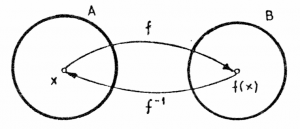 Recall that a bijective function is a one-to-one correspondence between
the set of inputs and the set of output values.
If $f$ is a bijective function, then there exists an inverse function $f^{-1}$,
which performs the inverse mapping of $f$.
Thus, if you start from some $x$, apply $f$ and then apply $f^{-1}$,
you will get back to the original input $x$:
\[
x = f^{-1}\!\left( \; f(x) \; \right).
\]
This is represented graphically in the diagram on the right.
Recall that a bijective function is a one-to-one correspondence between
the set of inputs and the set of output values.
If $f$ is a bijective function, then there exists an inverse function $f^{-1}$,
which performs the inverse mapping of $f$.
Thus, if you start from some $x$, apply $f$ and then apply $f^{-1}$,
you will get back to the original input $x$:
\[
x = f^{-1}\!\left( \; f(x) \; \right).
\]
This is represented graphically in the diagram on the right.
Function composition
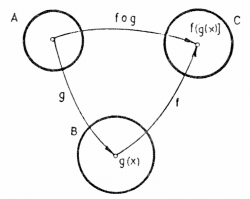 We can combine two simple functions to build a more complicated function
by chaining them together.
The resulting function is denoted
\[
z = f\!\circ\!g \, (x) \equiv z = f\!\left( \: g(x) \: \right).
\]
We can combine two simple functions to build a more complicated function
by chaining them together.
The resulting function is denoted
\[
z = f\!\circ\!g \, (x) \equiv z = f\!\left( \: g(x) \: \right).
\]
The diagram on the left shows a function $g:A\to B$ acting on some input $x$ to produce an intermediary value $y \in B$, which is then input to the function $f:B \to C$ to produce the final output value $z = f(y) = f(g(x))$.
The composition of applying $g$ first followed by $f$ is a function of the form: $f\circ g: A \to C$ defined through the equation $f\circ g(x) = f(g(x))$. Note that “first” in the context of function composition means the first to first to touch the input.
Discussion
In the next sections, we will look into the different functions that you will be dealing with. What we present here is far from and exhaustive list, but if you get a hold of these ones, you will be able to solve any problem a teacher can throw at you.
Links
[ Tank game where you specify the function of the projectile trajectory ]
http://www.graphwar.com/play.html
NOINDENT
[ Gallery of function graphs ]
http://mpmath.googlecode.com/svn/gallery/gallery.html
Polynomials
The polynomials are a very simple and useful family of functions. For example quadratic polynomials of the form $f(x) = ax^2 + bx +c$ often arise in the description of physics phenomena.
Definitions
- $x$: the variable
- $f(x)$: the polynomial. We sometimes sometimes denote polynomials $P(x)$ to
distinguish them from generic function $f(x)$.
- degree of $f(x)$: the largest power of $x$ that appears in the polynomial
- roots of $f(x)$: the values of $x$ for which $f(x)=0$
Polynomials
The most general polynomial of the first degree is a line $f(x) = mx + b$, where $m$ and $b$ are arbitrary constants.
The most general polynomial of second degree is $f(x) = a_2 x^2 + a_1 x + a_0$, where again $a_0$, $a_1$ and $a_2$ are arbitrary constants. We call $a_k$ the coefficient of $x^k$ since this is the number that appears in front of it.
By now you should be able to guess that a third degree polynomial will look like $f(x) = a_3 x^3 + a_2 x^2 + a_1 x + a_0$.
In general, a polynomial of degree $n$ has equation: \[ f(x) = a_n x^n + a_{n-1}x^{n-1} + \cdots + a_2 x^2 + a_1 x + a_0. \] or if you want to use the sum notation we can write it as: \[ f(x) = \sum_{k=0}^n a_kx^k, \] where $\Sigma$ (the capital Greek letter sigma) stands for summation.
Solving polynomial equations
Very often you will have to solve a polynomial equations of the form: \[ A(x) = B(x), \] where $A(x)$ and $B(x)$ are both polynomials. Remember that solving means to find the value of $x$ which makes the equality true.
For example, say the revenue of your company, as function of the number of products sold $x$ is given by $R(x)=2x^2 + 2x$ and the costs you incur to produce $x$ objects is $C(x)=x^2+5x+10$. A very natural question to ask is the amount of product you need to produce to break even, i.e., to make your revenue equal your costs $R(x)=C(x)$. To find the break-even $x$, you will have to solve the following equation: \[ 2x^2 + 2x = x^2+5x+10. \]
This may seem complicated since there are $x$s all over the place and it is not clear how to find the value of $x$ that makes this equation true. No worries though, we can turn this equation into the “standard form” and then use the quadratic equation. To do this, we will move all the terms to one side until we have just zero on the other side: \[ \begin{align} 2x^2 + 2x \ \ \ -x^2 &= x^2+5x+10 \ \ \ -x^2 \nl x^2 + 2x \ \ \ -5x &= 5x+10 \ \ \ -5x \nl x^2 - 3x \ \ \ -10 &= 10 \ \ \ -10 \nl x^2 - 3x -10 &= 0. \end{align} \]
Remember that if we do the same thing on both sides of the equation, it remains true. Therefore, the values of $x$ that satisfy \[ x^2 - 3x -10 = 0, \] namely $x=-2$ and $x=5$, will also satisfy \[ 2x^2 + 2x = x^2+5x+10, \] which was the original problem that we were trying to solve.
This “shuffling of terms” approach will work for any polynomial equation $A(x)=B(x)$. We can always rewrite it as some $C(x)=0$, where $C(x)$ is a new polynomial that has as coefficients the difference of the coefficients of $A$ and $B$. Don't worry about which side you move all the coefficients to because $C(x)=0$ and $0=-C(x)$ have exactly the same solutions. Furthermore, the degree of the polynomial $C$ can be no greater than that of $A$ or $B$.
The form $C(x)=0$ is the standard form of a polynomial and, as you will see shortly, there are formulas which you can use to find the solution(s).
Formulas
The formula for solving the polynomial equation $P(x)=0$ depend on the degree of the polynomial in question.
First
For first degree: \[ P_1(x) = mx + b = 0, \] the solution is $x=b/m$. Just move $b$ to the other side and divide by $m$.
Second
For second degree: \[ P_2(x) = ax^2 + bx + c = 0, \] the solutions are $x_1=\frac{-b + \sqrt{ b^2 -4ac}}{2a}$ and $x_2=\frac{-b - \sqrt{b^2-4ac}}{2a}$.
Note that if $b^2-4ac < 0$, the solutions involve taking the square root of a negative number. In those cases, we say that no real solutions exist.
Third
The solutions to the cubic polynomial equation \[ P_3(x) = x^3 + ax^2 + bx + c = 0, \] are given by \[ x_1 = \sqrt[3]{ q + \sqrt{p} } \ \ + \ \sqrt[3]{ q - \sqrt{p} } \ -\ \frac{a}{3}, \] and \[ x_{2,3} = \left( \frac{ -1 \pm \sqrt{3}i }{2} \right)\sqrt[3]{ q + \sqrt{p} } \ \ + \ \left( \frac{ -1 \pm \sqrt{3}i }{2} \right) \sqrt[3]{ q - \sqrt{p} } \ - \ \frac{a}{3}, \] where $q \equiv \frac{-a^3}{27}+ \frac{ab}{6} - \frac{c}{2}$ and $p \equiv q^2 + \left(\frac{b}{3}-\frac{a^2}{9}\right)^3$.
Note that, in my entire career as an engineer, physicist and computer scientist, I have never used the cubic equation to solve a problem by hand. In math homework problems and exams you will not be asked to solve equations of higher than second degree, so don't bother memorizing the solutions of the cubic equation. I included the formula here just for completeness.
Higher degrees
There is also a formula for polynomials of degree $4$, but it is complicated. For polynomials with order $\geq 5$, there does not exist a general analytical solution.
Using a computer
When solving real world problems,
you will often run into much more complicated equations.
For anything more complicated than the quadratic equation,
I recommend that you use a computer algebra system like
sympy to find the solutions.
Go to http://live.sympy.org and type in:
>>> solve( x**2 - 3*x +2, x) [ shift + Enter ] [1, 2]
Indeed $x^2-3x+2=(x-1)(x-2)$ so $x=1$ and $x=2$ are the two solutions.
Substitution trick
Sometimes you can solve polynomials of fourth degree by using the quadratic formula. Say you are asked to solve for $x$ in \[ g(x) = x^4 - 3x^2 -10 = 0. \] Imagine this comes up on your exam. Clearly you can't just type it into a computer, since you are not allowed the use of a computer, yet the teacher expects you to solve this. The trick is to substitute $y=x^2$ and rewrite the same equation as: \[ g(y) = y^2 - 3y -10 = 0, \] which you can now solve by the quadratic formula. If you obtain the solutions $y=\alpha$ and $y=\beta$, then the solutions to the original fourth degree polynomial are $x=\sqrt{\alpha}$ and $x=\sqrt{\beta}$ since $y=x^2$.
Of course, I am not on an exam, so I am allowed to use a computer:
>>> solve(y**2 - 3*y -10, y) [-2, 5] >>> solve(x**4 - 3*x**2 -10 , x) [sqrt(2)i, -sqrt(2)i, -sqrt(5) , sqrt(5) ]
Note how a 2nd degree polynomial has two roots and a fourth degree polynomial has four roots, two of which are imaginary, since we had to take the square root of a negative number to obtain them. We write $i=\sqrt{-1}$. If this was asked on an exam though, you should probably just report the two real solutions: $\sqrt{5}$ and $-\sqrt{5}$ and not talk about the imaginary solutions since you are not supposed to know about them yet. If you feel impatient though, and you want to know about the complex numbers right now you can skip ahead to the section on complex numbers.
Trigonometry
Put together any three lines and you get a triangle. In particular, if the triangle has one of its angles equal to $90^\circ$, we call this a right angle triangle.
In this section we are going to discuss right angle triangles in great detail and get used to their properties. You will learn how to use fancy Greek words like sinus, cosinus and tangent in order to refer to the various ratios of lengths in the triangle.
Understanding triangles and the trigonometric functions associated with them will be of fundamental importance for your later understanding of mathematics subjects like vectors and complex numbers and physics subjects like oscillations and waves.
Concepts
- $A,B,C$: the three vertices of the triangle
- $\theta$: the angle at the vertex $C$. Angles can be measured in degrees or radians.
- $\text{opp} \equiv \overline{AB}$: the length of the opposite side to $\theta$
- $\text{adj} \equiv \overline{BC}$: the length of side adjacent to $\theta$
- $\text{hyp} \equiv \overline{AC}$: the hypotenuse is longest side in the triangle
- $h$: the “height” of the triangle (in this case $h = \text{opp} = \overline{AB}$)
- $\sin\theta \equiv \frac{\text{opp}}{\text{hyp}}$: the sinus of theta, is the ratio of the lengths of the opposite side and the hypotenuse
- $\cos\theta \equiv \frac{\text{adj}}{\text{hyp}}$: the cosinus of theta, is the ratio of the adjacent and the hypotenuse lengths
- $\tan\theta \equiv \frac{\sin\theta}{\cos\theta} \equiv \frac{\text{opp}}{\text{adj}}$: the tangent is the ratio of the opposite divided by the adjacent
Pythagoras theorem
In a right angle triangle, the length of the hypotenuse squared is equal to the sum of the squares of the lengths of the other sides: \[ |\text{adj}|^2 + |\text{opp}|^2 = |\text{hyp}|^2. \]
If we divide both sides of the above equation by $|\text{hyp}|^2$ we obtain \[ \frac{|\text{adj}|^2}{ |\text{hyp}|^2 } + \frac{|\text{opp}|^2}{ |\text{hyp}|^2 } = 1, \] which can be rewritten as: \[ \cos^2\theta \ + \sin^2\theta = 1. \] This is a powerful trigonometric identity: a relationship between $\sin$ and $\cos$.
Sin and cos
Meet the trigonometric functions, or trigs for short. These are your new friends. Don't be shy now, say hello to them.
“Hello.”
“Hi.”
“Soooooo, you are like functions right?”
“Yep,” sin and cos reply in chorus.
“Okkkkkk, so what do you do?”
“Who me?”, asks cos, “well I tell the ratio.. Hmm..
wait, were you asking what I do as a function or specifically
what I do?”
“Both I guess?”
“Ok so as a function, I take angles as inputs and I give ratios as answers.
More specifically, I tell you how wide a triangle with that angle will be,”
says cos all in one breath.
“What do you mean wide?”, you ask.
“Oh yeah, I forgot to say, the triangle has to have hypotenuse of length 1.
So you see what happens is that, there is like a point $P$ that moves
around on a circle of radius 1, and we imagine a triangle that has
corners the origin, the point $P$ and the point on the $x$ axis that is
right below the point $P$.”
“I am not sure I get it,” you confess.
“Let me try to explain then”, says sin, “cos is always the one
to start off big and confuse people. I will start from zero.”
“OK. Sure. I mean I just don't see what circle cos is talking about.”
“Look on the next page, you will see a circle. The unit circle because
it has radius one. You see it yes?”
“Yes.”
“The circle thing really cool. Imagine a point $P$ which stators from
the point $P(0)=(1,0)$ and moves in a circle of radius one.
The $x$ and $y$ coordinates of the point $P(\theta)=(P_x(\theta),\ P_y(\theta))$
as a function of $\theta$ are given by:
\[
P(\theta)=(P_x(\theta),\ P_y(\theta)) = (\cos\theta, \ \sin\theta ).
\]
So, either you think of us in the context of triangles
or you think of us in the context of the unit circle.”
“OK. Cool. I kind of get it,” you say it to keep conversation,
but in reality you are all weirded out. Talking functions?
“Well, thank you guys. It was nice to meet you, but you
know I have to get going now, so see you later,” you say to
get out the situation.
“OK. Peace out,” says sin, “anyways we are done here, since I told you the most important things.”
“See you later,” says cos.
The unit circle
You should be familiar with the values of $\sin$ and $\cos$ for all the angles that are multiples of $\frac{\pi}{6}$ ($30^\circ$) or $\frac{\pi}{4}$ ($45^\circ$). All of them are shown in the diagram below. For each angle, the $x$ coordinate (the first number in the brackets below) is $\cos$ and the $y$ coordinate is $\sin$.
You might think that there is too much to remember. “Dude”, you say, “I was listening to your advice until now and learning, but now you are telling me to remember all those values with so many square roots in them. How am I to remember all of that?”
Actually, you just have to memorize one fact: \[ \sin(30^\circ) = \sin\!\!\left( \frac{\pi}{6} \right) = \frac{1}{2}. \]
My dad was like “You have to put this in the book”, and he is right. You can figure out all the other angles from this one. Let's start with $\cos(30^\circ)$. We know that the point $P$ on the unit circle at $30^\circ$ has vertical coordinate $\frac{1}{2}=\sin(30^\circ)$, and that by definition the horizontal component is the $\cos$ quantity we are looking for: \[ P = (\cos(30^\circ), \sin(30^\circ) ). \]
The key fact about the unit circle, is that all the points or it are at distance one from the centre. So knowing that $P$ is on the unit circle, and the value of $\sin(30^\circ)$, we can solve for $\cos(30^\circ)$. Indeed we start from the identity: \[ \cos^2\theta \ + \sin^2\theta = 1, \] which is true for all angles $\theta$. Moving things around, we obtain: \[ \cos(30^\circ) = \sqrt{ 1 - \sin^2(30^\circ) } = \sqrt{ 1 - \frac{1}{4} } = \sqrt{ \frac{3}{4} } = \frac{\sqrt{3}}{2}. \]
To get the values of $\cos(60^\circ)$ and $\sin(60^\circ)$, observe the symmetry of the circle. Sixty degrees measured from the $x$ axis, is the same as thirty degrees measured from the $y$ axis. So immediately you know that $\cos(60^\circ)=\sin(30^\circ)=\frac{1}{2}$. Therefore, it must be that $\sin(60^\circ) = \frac{\sqrt{3}}{2}$.
To get the values of sin and cos for angles that are multiples of $45^\circ$, we need to find the value $a$ such that \[ a^2 + a^2 = 1, \] since at $45^\circ$ both the horizontal part and the vertical part will be of the same length. The answer is obviously $a=\frac{1}{\sqrt{2}}$, but because people don't like to see square roots in the denominator we have to write: \[ \frac{\sqrt{2}}{2} = \cos(45^\circ) = \sin(45^\circ). \]
All of the other angles in the circle are just like the above three, but they have a negative sign in one or more of the components. Don't memorize them, but if you ever need one of their values draw a little circle and use the symmetry of the circle to find them. For example, $150^\circ$ is just like $30^\circ$, except the $x$ component is negative.
Non-unit circles
Consider now a point $Q(\theta)$ at an angle of $\theta$ on a circle of radius $R\neq1$. How can we find the $x$ and $y$ coordinates of the point $Q(\theta)$?
We saw that the coefficients $\cos\theta$ and $\sin\theta$ correspond the $x$ and $y$ coordinates of a point on the unit circle ($R=1)$. To obtain the coordinates for a point on a circle of radius $R$ we must scale the coordinates by a factor of $R$: \[ Q(\theta) = (Q_x(\theta), Q_y(\theta) ) = ( R\cos\theta, R\sin\theta ). \]
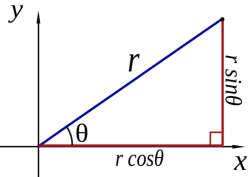 The take home message is that the functions $\cos\theta$ and $\sin\theta$
are generally useful for finding the “horizontal” and “vertical” components
of any length $r$.
The take home message is that the functions $\cos\theta$ and $\sin\theta$
are generally useful for finding the “horizontal” and “vertical” components
of any length $r$.
From this point on in the book, we will always talk about the length of the adjacent side as $r_x=r\cos\theta$ and the opposite side as $r_y = r\sin\theta$. It is extremely important that you get comfortable with this notation.
The reasoning behind the above calculations is as follows: \[ \begin{align*} \cos\theta \equiv \frac{\text{adj}}{\text{hyp}} = \frac{r_x}{r} & \quad \Rightarrow \quad r_x = r \cos\theta, \nl \sin\theta \equiv \frac{\text{opp}}{\text{hyp}}=\frac{r_y}{r} & \quad \Rightarrow \quad r_y = r\sin\theta. \end{align*} \]
Calculators
Make sure your calculator is set to the right units for angles. If you wanted to compute the sinus of 30 degrees what should you type into your calculator?
If you calculator is set to degrees then simply
type sin + 30 + =.
But what if your calculator is set to radians? You have two options:
- Change the
modeof the calculator so it works in degrees. - Convert $30^\circ$ to radians
\[ 30 \ [^\circ] \times \frac{ 2\pi \ [\text{rad}] }{ 360 \ [^\circ] } = \frac{\pi}{6} \ \text{[rad]}, \]
so you should type ''sin'' + $\pi$ + ''/'' + ''6'' + ''='' on your calculator.
Trigonometric identities
There is a number of important relationships between the values of the functions $\sin$ and $\cos$. These are known as trigonometric identities. There are three of them which you should memorize, and about a dozen others which are less important.
Formulas
The trigonometric functions are defined as \[ \cos(\theta)=x_P~~,~~\sin(\theta)=y_P~~,~~\tan(\theta)=\frac{y_P}{x_P}, \] where $P=(x_P,y_P)$ is a point on the unit circle.
The three identities that you must remember are:
1. Unit hypotenuse
\[ \sin^2(x)+\cos^2(x)=1. \] This is true by Pythagoras theorem and the definition of sin and cos. The ratios of the squares of the sides of a triangle is equal to the square of the size of the hypotenuse.
2. sico + sico
\[ \sin(a + b)=\sin(a)\cos(b) + \sin(b)\cos(a). \] The mnemonic for this one is “sico sico”.
3. coco - sisi
\[ \cos(a + b)=\cos(a)\cos(b) - \sin(a)\sin(b). \] The mnemonic for this one is “coco - sisi”—the negative sign is there because it is not good to be a sissy.
Derived formulas
If you remember the above thee formulas, you can derive pretty much all the other trigonometric identities.
Double angle formulas
Starting from the sico-sico identity above, and setting $a=b=x$ we can derive following identity: \[ \sin(2x) = 2\sin(x)\cos(x). \]
Starting from the coco-sisi identity, we derive: \[ \cos(2x) \ =\ 2\cos^2(x) - 1 \ = 2\left(1 - \sin^2(x)\right) - 1 = 1 - 2\sin^2(x), \] or if we rewrite to isolate the $\sin^2$ and $\cos^2$ we get: \[ \cos^2(x) = \frac{1}{2}\left(1+\cos(2x)\right), \qquad \sin^2(x) = \frac{1}{2}\left(1-\cos(2x)\right). \]
Self similarity
Sin and cos are periodic functions with period $2\pi$. So if we add multiples of $2\pi$ to the input, we get the same value: \[ \sin(x + 2\pi)=\sin(x +124\pi) = \sin(x), \qquad \cos(x+2\pi)=\cos(x). \]
Furthermore, sin and cos are self similar within each $2\pi$ cycle: \[ \sin(\pi-x)=\sin(x), \qquad \cos(\pi-x)=-\cos(x). \]
Sin is cos, cos is sin
Now it should come and no surprise if I tell you that actually sin and cos are just $\frac{\pi}{2}$-shifted versions of each other: \[ \cos(x)=\sin\!\left(x\!+\!\frac{\pi}{2}\right)=\sin\!\left(\frac{\pi}{2}\!-\!x\right), \ \ \sin\!\left(x\right) = \cos\left(x\!-\!\frac{\pi}{2}\right) = \cos\left(\frac{\pi}{2}\!-\!x\right). \]
Sum formulas
\[ \sin\!\left(a\right)+\sin\!\left(b\right)=2\sin\!\left(\frac{1}{2}(a+b)\right)\cos\!\left(\frac{1}{2}(a-b)\right), \] \[ \sin\!\left(a\right)-\sin\!\left(b\right)=2\sin\!\left(\frac{1}{2}(a-b)\right)\cos\!\left(\frac{1}{2}(a+b)\right), \] \[ \cos\!\left(a\right)+\cos\!\left(b\right)=2\cos\!\left(\frac{1}{2}(a+b)\right)\cos\!\left(\frac{1}{2}(a-b)\right), \] \[ \cos\!\left(a\right)-\cos\!\left(b\right)=-2\sin\!\left(\frac{1}{2}(a+b)\right)\sin\!\left(\frac{1}{2}(a-b)\right). \]
Product formulas
\[ \sin(a)\cos(b) = {1\over 2}(\sin{(a+b)}+\sin{(a-b)}), \] \[ \sin(a)\sin(b) = {1\over 2}(\cos{(a-b)}-\cos{(a+b)}), \] \[ \cos(a)\cos(b) = {1\over 2}(\cos{(a-b)}+\cos{(a+b)}). \]
Discussion
The above formulas will come in handy in many situations when you have to find some unknown in an equation or when you are trying to simplify a trigonometric expression. I am not saying you should necessarily memorize them, but you should be aware that they exist.
Geometry
Triangles
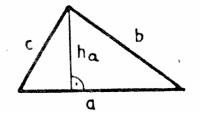 The area of a triangle is equal to $\frac{1}{2}$
times the length of the base times the height:
\[
A = \frac{1}{2} a h_a.
\]
Note that $h_a$ is the height of the triangle relative to the side $a$.
The area of a triangle is equal to $\frac{1}{2}$
times the length of the base times the height:
\[
A = \frac{1}{2} a h_a.
\]
Note that $h_a$ is the height of the triangle relative to the side $a$.
The perimeter of the triangle is: \[ P = a + b + c. \]
Consider now a triangle with internal angles $\alpha$, $\beta$ and $\gamma$. The sum of the inner angles in any triangle is equal to two right angles: $\alpha+\beta+\gamma=180^\circ$.
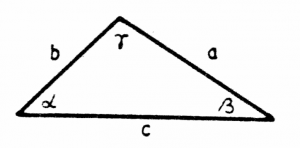 The sine law is:
\[
\frac{a}{\sin(\alpha)}=\frac{b}{\sin(\beta)}=\frac{c}{\sin(\gamma)},
\]
where $\alpha$ is the angle opposite to $a$, $\beta$ is the angle opposite to $b$ and $\gamma$ is the angle opposite to $c$.
The sine law is:
\[
\frac{a}{\sin(\alpha)}=\frac{b}{\sin(\beta)}=\frac{c}{\sin(\gamma)},
\]
where $\alpha$ is the angle opposite to $a$, $\beta$ is the angle opposite to $b$ and $\gamma$ is the angle opposite to $c$.
The cosine rules are: \[ \begin{align} a^2 & =b^2+c^2-2bc\cos(\alpha), \nl b^2 & =a^2+c^2-2ac\cos(\beta), \nl c^2 & =a^2+b^2-2ab\cos(\gamma). \end{align} \]
Sphere
A sphere is described by the equation \[ x^2 + y^2 + z^2 = r^2. \]
Surface area: \[ A = 4\pi r^2. \]
Volume: \[ V = \frac{4}{3}\pi r^3. \]
Cylinder
The surface area of a cylinder consists of the top and bottom circular surfaces plus the area of the side of the cylinder: \[ A = 2 \left( \pi r^2 \right) + (2\pi r) h. \]
The volume is given by product of the area of the base times the height of the cylinder: \[ V = \left(\pi r^2 \right)h. \]
Example
You open the hood of your car and see 2.0L written on top of the engine. The 2[L] refers to the total volume of the four pistons, which are cylindrical in shape. You look in the owner's manual and find out that the diameter of each piston (bore) is 87.5[mm] and the height of each piston (stroke) is 83.1[mm]. Verify that the total volume of the cylinder displacement of your engine is indeed 1998789[mm$^3$] $\approx 2$[L].
Links
[ A formula for calculating the distance between two points on a sphere ]
http://www.movable-type.co.uk/scripts/latlong.html
Circle
The circle is a set of points that are a constant distance from the centre. It is a very simple geometrical shape which comes up in many situations.
Definitions
- $r$: the radius of the circle
- $A$: the area of the circle
- $C$: the circumference of the circle
- $(x,y)$: is a point on the circle
- $\theta$: the angle (measured from the $x$-axis) of some point on the circle.
Formulas
The circle of radius $r$ centred at the origin is described by the following equation: \[ x^2 + y^2 = r^2. \] All points $(x,y)$ which satisfy this equation are part of the circle.
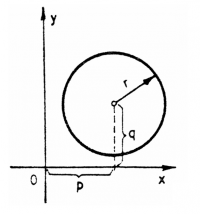 Instead of being centred at the origin, the
centre of the circle could be at any point in the plane $(p,q)$:
\[
(x-p)^2 + (y-q)^2 = r^2.
\]
Instead of being centred at the origin, the
centre of the circle could be at any point in the plane $(p,q)$:
\[
(x-p)^2 + (y-q)^2 = r^2.
\]
Explicit function
The equation of a circle is a relation or an implicit function involving $x$ and $y$. If we want an explicit function $f(x)$ for the circle, we can solve for $y$ to obtain: \[ y = \sqrt{ r^2 - x^2}, \quad -r \leq x \leq r, \] and \[ y = -\sqrt{ r^2 - x^2}, \quad -r \leq x \leq r. \] There are two functions, because a vertical line crosses that circle in two places. The first function corresponds to the top half of the circle and the second function corresponds to the bottom half.
Polar coordinates
Circles are such a common shape in mathematics that mathematicians developed a special “circular coordinate system” in order to describe them more easily.
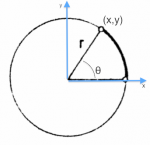 It is possible to specify the coordinates $(x,y)$ of any point on the circle
in terms of the polar coordinates $r\angle\theta$, where $r$ measures the distance of
the point from the origin and $\theta$ is the angle measured from the $x$ axis.
It is possible to specify the coordinates $(x,y)$ of any point on the circle
in terms of the polar coordinates $r\angle\theta$, where $r$ measures the distance of
the point from the origin and $\theta$ is the angle measured from the $x$ axis.
To convert from the polar coordinates $r\angle\theta$ to the $(x,y)$ coordinates we use the trigonometric functions: \[ x = r\cos \theta, \qquad y = r\sin \theta. \]
Parametric equation
We can describe all the points on the circle in we specify a fixed radius $r$ and vary the angle $\theta$ over all angles: $\theta \in [0, 360^\circ)$. A parametric equation specifies the coordinates $(x(\theta), y(\theta))$ for the points on a curve for all values of the paramter $\theta$. The parametric equation for a circle of radius $r$ is given by: \[ \{ (x,y)\in\mathbb{R}^2 \ | \ x=r \cos\theta, y = r\sin\theta, \ \theta \in [0, 360^\circ) \}. \] You should try to visualize the curve traced by the point $(x(\theta),y(\theta))=(r\cos\theta,r\sin\theta)$ as $\theta$ varies from $0$ to $360^\circ$ and convince yourself that it traces out a circle of radius $r$.
If we let the parameter $\theta$ vary over a smaller interval, we will obtain subsets of the circle. For example, the parametric equation for the top half of the circle is: \[ \{ (x,y)\in\mathbb{R}^2 \ | \ x=r \cos\theta, y = r\sin\theta, \ \theta \in [0, 180^\circ] \}. \] The top half of the circle is also described by $\{ (x,y) \in\mathbb{R}^2 \ | \ y = \sqrt{ r^2 - x^2},\ x \in [-r,r] \}$, where the parameter used is the $x$ coordinate.
Area
The area of a circle of radius $r$ is given by \[ A = \pi r^2. \]
Circumference and arc length
The circumference of a circle is \[ C = 2 \pi r. \] This is the total length you would measure out if you were to follow the line of the circle.
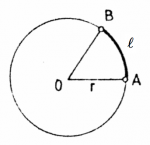 What is the length of a part of the circle?
Say you have a piece of the circle, that corresponds
to the angle $\theta=30^\circ$. What is its length?
If the total length is $C=2 \pi r$ corresponds to
doing a full turn around the circle $360^\circ$, then
the arc length $\ell$ for a portion which corresponds to the angle $\theta$ is
\[
\ell = 2 \pi r \frac{\theta}{360}.
\]
We say that $\ell$ is the act length subtended by the angle $\theta$.
What is the length of a part of the circle?
Say you have a piece of the circle, that corresponds
to the angle $\theta=30^\circ$. What is its length?
If the total length is $C=2 \pi r$ corresponds to
doing a full turn around the circle $360^\circ$, then
the arc length $\ell$ for a portion which corresponds to the angle $\theta$ is
\[
\ell = 2 \pi r \frac{\theta}{360}.
\]
We say that $\ell$ is the act length subtended by the angle $\theta$.
Radians
Though degrees are a commonly used unit for angles, it is much better to measure angles in radians, which is the natural angle parameter. The conversion ratio is: \[ 2\pi \ \text{[radians]} = 360 \ \text{[degrees]}. \] For a circle of radius $r=1$, the arc length is equal to the angle in radians: \[ \ell = \theta_{radians}. \] Measuring radians is equivalent to measuring arc length on a circle of radius one.
Ellipse
The orbit of planet Earth around the Sun is an ellipse.
Definitions
- $a$: the half-length of the ellipse along the $x$ axis, also known as the semi-major axis.
- $b$: the half-length of the ellipse along the $y$ axis.
- $F_1,F_2$: the two focal points of the ellipse.
- $\epsilon$: the eccentricity of the ellipse.
- $(x,y)$: a point on the ellipse.
- $r_1$: the distance from the point $(x,y)$ on the ellipse to $F_1$.
- $r_2$: the distance from the point $(x,y)$ on the ellipse to $F_2$.
Formulas
An ellipse is the curve you get if you trace out all the points such that the sum of the distances to the focal points is a constant length: \[ r_1 + r_2 = \text{const}. \]
There is a really neat way to draw a perfect ellipse using a piece of string and two tacks (pins). Take a piece of string and tack it to a picnic table at two points such that it is loose in the middle. Now take a pencil and without touching the table move the string until both sides are tout. Make a mark at that point. Since the two parts of the string are completely straight, their sum length, $r_1+r_2$ is the length of the whole piece, which plays the role of the constant in the above equation. When you make a mark at every point possible where the two “legs” of string are kept tout you get the following curve:
The mathematical formula for the ellipse is: \[ \frac{x^2}{a^2} + \frac{y^2}{b^2} = 1, \] where in the above drawing we have $a>b$ so the ellipse is elongated on the $x$ axis.
The coordinates of the focal points are: \[ F_1 = (-e,0), \qquad F_2 = (e,0), \] where $e=\sqrt{a^2 - b^2}$. The focal points correspond to the locations of the two tacks where the string is held fixed.
An important related quantity is the eccentricity: \[ \epsilon \equiv \sqrt{1- \frac{b^2}{a^2} }=\frac{e}{a} , \] which describes the shape of the ellipse in a scale-less fashion. The bigger $\epsilon$ the bigger the difference in the length of the major-axis and the minor-axis. In the special case when $\epsilon=0$, the equation of the ellipse becomes a circle of radius $a$.
Polar coordinates
Polar functions $r(\theta)$ describe the distance of some point from the centre as a function of the angle $\theta$ the point makes with the $x$-axis. Thus in the coordinate system $(r,\theta)$, the independent variable is $\theta$ and the dependent variable is $r$.
If we setup a polar coordinate system with centre at the origin $C=(0,0)$, the equation of the ellipse will be: \[ r(\theta) = \frac{ab}{b^2\cos^2(\theta) + a^2\sin^2(\theta)}. \]
For many applications, it is more convenient to put the centre of the polar coordinates system at $F_1$, the left focal point. Suppose that $(r_1,\phi)$ is a polar coordinate system with centre $C=F_1=(-e,0)$, then the equation of the ellipse is \[ r_1(\phi) = \frac{a(1-\epsilon^2)}{1 - \epsilon\cos(\phi)}, \] where the angle $\phi$ is with respect to the positive $x$-axis.
Applications
Orbit of the Earth around the Sun
To a very good approximation, the motion of the earth around the sun is described by an ellipse with the sun at one focus. The distance of the earth from the sun (positioned at $F_1$, so we are talking about $r_1$) as a function of the angle $\phi$ is given by: \[ r_1(\phi) = \frac{a(1-\epsilon^2)}{1 - \epsilon\cos(\phi)}. \]
The eccentricity of the earth's orbit around the sun is $\epsilon = 0.01671123 $ and the half-length of the major axis is $a=149\:598\:261$[km]. So the distance sun-earth $r_1$ is given by the equation: \[ r_{1}(\phi) = \frac{149556484.56}{1 - 0.01671123\cos(\phi)} \text{[km]}. \]
The moment where the earth is most distant from the sun is called aphelion and occurs around January 3rd. The closet point is called perihelion and it usually occurs around July 4th. The aphelion distance of the earth happens when $\phi=0$ so we have \[ r_{1,aphe}=r_1(0) = \frac{149556483}{1 - 0.01671123\cos(0)} = 152098232 \text{[km]}, \] and the closes pass of the earth near the sun is when $\phi=\pi$ at \[ r_{1,peri} = r_1(\pi) = \frac{149556483}{1 - 0.01671123\cos(\pi)} = 147098290 \text{[km]}. \] If you don't trust me, look up the numbers on wikipedia and compare them with the above predictions.
The angle $\phi$ of the earth relative to the sun, is a function of time. If we measure $t$ in days we have the following lookup table:
| t (day) | 1 | 2 | . | 182 | . | 365 | 365.242199 |
|---|---|---|---|---|---|---|---|
| t (date) | July 3 | July 4 | . | Jan 3 | . | July 2 | ? |
| phi (deg) | 0 | . | 180 | . | 359.761356 | 360 | |
| phi (rad) | 0 | . | pi | . | 6.27902 | 2 pi |
Note the extra amount of “day” that is roughly equal to $\frac{1}{4}=0.25$. Ever wonder why one of every four years is a leap year? That is why.
The exact formula of the function $\phi(t)$ that describes the angle as a function of time is complicated, but computable.
Note that the varying distance of the earth from the sun is not the cause of seasons. Seasons are predominantly caused by the tilt of the earth relative to the plane of its orbit around the sun. The day the tilt of the earth spin axis aligns with sun is either the longest day or the shortest day of the year, depending on which hemisphere you are in (the North or the South). We call those days solstices.
Newton's insight
Contrary to what is commonly believed, Newton did not come up with his theory of gravitation while sitting under a tree because an apple fell on his head. What actually happened is that he started from Kepler's laws of motion which describes the exact elliptical orbit of the Earth as a function of time. Newton asked “what kind of force would cause two bodies to spin around each other in an elliptical orbit” and he deducted that the gravitational force between the sun of mass $M$ and the earth of mass $m$ must be of the form $F_g=\frac{GMm}{r^2}$. We have to give props to the man, for connecting the dots, and we have to give props to Johannes Kepler studying the orbital periods and Tycho Brahe for doing all the astronomical measurements. Above all, we have to give props to the ellipse for being such an awesome shape.
Links
Set notation
A set is mathematically precise way to talk about different groups of objects. To do simple math, you don't need to know about sets, but for more advanced topics you need to know what a set is and how we denote set membership and subset relations between sets.
Definitions
- set: some collection of mathematical objects with a precise definition.
- $S,T$: usual variable names for sets.
- $\mathbb{N}, \mathbb{Z}, \mathbb{Q}, \mathbb{R}$: some important sets of numbers. These correspond to the naturals, the integers,
the rationals and the real numbers respectively.
- $\{ definition \}$: The curly brackets are used to surround the definition of a set and the expression inside is supposed
to completely describe what the set is.
NOINDENT Set operations:
- $S\cup T$: the union of two sets. The elements that are either in $S$ or $T$.
- $S \cap T$: the intersection of the two sets. The elements that are in both $S$ and $T$.
- $S \setminus T$: set minus. The elements of $S$ that are not in $T$.
NOINDENT Set relations:
- $\subset$: is a subset of.
- $\subseteq$: is subset or equal to.
NOINDENT Special mathematical shorthand and corresponding meaning in English:
- $\forall$: for all
- $\exists$: there exists
- $\nexists$: there doesn't exist
- $:$ or $|$: such that
- $\in$: is element of
- $\notin$: is not an element of
Sets
A lot of the power of math comes from abstraction: the ability to think meta thoughts and seeing the bigger picture about what math objects have in common. We can think of individual numbers like $3$, $5$ and $222$ or talk about the set of all numbers. You can think of functions like $f(x)=x$, and $f(x)=x^2$ or you can think of the set of all functions $f\colon \mathbb{R} \to \mathbb{R}$ that take real numbers as inputs and give real numbers as outputs.
Example 1: Non-negative numbers
Define $\mathbb{R}_+ \subset \mathbb{R}$ to be the set of non-negative real numbers: \[ \mathbb{R}_+ = \{ \text{all } x \text{ from } \mathbb{R} \text{ such that } x \geq 0 \}, \] or expressed more compactly: \[ \mathbb{R}_+ = \{ x \in \mathbb{R} \ | \ x \geq 0 \}. \]
Example 2: Odd and even
Define the set of even integers as: \[ E = \{ n \in \mathbb{Z} \ | \ \frac{n}{2} \in \mathbb{Z} \} = \{ \ldots, -2, 0, 2, 4, 6, \ldots \}. \] and the set of odd integers as: \[ O = \{ n \in \mathbb{Z} \ | \ \frac{n+1}{2} \in \mathbb{Z} \} = \{ \ldots, -3, -1, 1, 3, 5, \ldots \}. \] In each case the mathematical notation $\{ \ldots \ | \ \ldots \}$ follows the same pattern where you first say what kind of objects we are talking about, followed by the “such that” sign $|$ followed by the conditions which must be satisfied by all elements of the set.
Important sets
The natural numbers are the set of number you can get by starting from $0$ and adding $1$ arbitraryly many times: \[ \mathbb{N} \equiv \{ 0, 1, 2, 3, 4, \ldots \}. \] The integers are the number you get by adding or subtracting 1 arbitrary many times: \[ \mathbb{Z} \equiv \{ \ldots, -3, -2, -1, 0, 1, 2, 3, 4, \ldots \}. \] If you allow for divisions between integers, you get the rational numbers: \[ \mathbb{Q} = \{ -1.5, 1/3, 22/7, 0.125, \ldots \}. \] The more general class of real numbers includes also irrational numbers: \[ \mathbb{R} = \{\pi, e, -1.53929411..,\ 4.99401940129401.., \ \ldots \}. \] Finally we have the set of complex numbers: \[ \mathbb{C} = \{ 1, i, 1+i, 2+3i, \ldots \}= \{ a + bi \ | \ a,b \in \mathbb{R}, i^2=-1 \}. \]
Note the inclusion relationship which holds for these sets: \[ \mathbb{N} \subset \mathbb{Z} \subset \mathbb{Q} \subset \mathbb{R} \subset \mathbb{C}. \] Every natural number is also an integer. Every integer is a rational number. Every rational number is a real. Every real number is also a complex number.
New vocabulary
Let's practice the new vocabulary by looking at a simple mathematical proof.
Square-root of two is irrational
Claim: $\sqrt{2} \notin \mathbb{Q}$. This means that there are no integers $m \in \mathbb{Z}$ and $n \in \mathbb{N}$ such that $m/n = \sqrt{2}$. The same sentence in mathematical notation would read: \[ \nexists m \in \mathbb{Z}, n\in\mathbb{N} \ | \ m/n = \sqrt{2}. \]
Proof: Suppose for a contradiction that there existed $m$ and $n$ such that $m/n=\sqrt{2}$. We can further assume that integers $m$ and $n$ are such that they have no common factors: we can always make sure this is the case if we cancel the common factors. In particular this implies that $m$ and $n$ cannot both be even since we would be able to cancel at least one factor of two. We therefore have $\textrm{gcd}(m,n)=1$: the their greatest common divisor is $1$. We will now investigate a simple question which is whether $m$ is an even number $m\in E$ or $m$ is an odd number $m \in O$.
Before we begin, lemme point out the fact that the action of squaring an integers preserves its odd/even nature. Indeed, an even number times an even number gives and even number: if $e \in E$ then $e^2 \in E$. Also an odd number times an odd number also gives an odd number: if $o \in O$ then $o^2 \in O$.
The proof proceeds as follows. We assumed that $m/n = \sqrt{2}$, so if we take the square of this equation we have: \[ \frac{m^2}{n^2} = 2, \qquad m^2 = 2n^2. \] If $m$ is an odd number then $m^2$ is also going to be odd, which contradicts the above equation since we see that $m^2$ “contains” a factor $2$, so $m \notin O$. If $m$ is even then $m^2$ is also an even number, so it can be written as $m=2q$ for some other number $q\in \mathbb{Z}$. The equation would then become: \[ 2^2 q^2 = 2 n^2 \quad \Rightarrow \quad 2 q^2 = n^2. \] This implies that $n \in E$ which leads to a contradiction with the fact that we said $m$ and $n$ cannot both be even. Therefore $m \notin E$, and since $m \notin O$ either, this means that there is no such $m \in \mathbb{Z}$ and therefore $\sqrt{2}$ is irrational.
Set relations and operations
We say that $B \subset A$ if $\forall b \in B$ we also have $b \in A$, and $\exists a \in A$, such that $a \notin B$. We say “$B$ is strictly contained in $A$” which is illustrated graphically in the figure below. Also illustrated in the figure is the union of two sets $A \cup B$ which includes all the elements of $A$ and $B$. We have $e \in A \cup B$, if and only if $e \in A$ or $e \in B$.
The set intersection is $A \cap B$ and set minus $A \setminus B$ are shown below.
Sets related to functions
The set of all functions of a real variable, that return a real variable is denoted: \[ f : \mathbb{R} \to \mathbb{R}. \]
The domain of a function is the set of all possible inputs. An input is not possible if the function is not defined for that input, like in the case of a “divide by zero” error.
The image set of a function is the set of all possible outputs of the function: \[ \textrm{Im}(f) = \{ y \in \mathbb{R} \ | \ \exists x\in\mathbb{R},\ y=f(x) \}. \]
Discussion
Knowledge of the precise mathematical jargon introduced in this section is not crucial to the rest of this book, but I wanted to expose you to it because this is the language in which mathematicians think. Most advanced math textbooks will take it for granted that you understand this kind of notation.
Compound interest
Soon after ancient civilizations invented the notion of numbers, they started computing interest on loans.
Percentages
We often talk about ratios between quantities, instead of the quantities themselves. For example, we can imagine working Joe who invests $1000$ in the stock market and loses $300$, because the boys on Wall Street keep pulling dirty tricks on him. To put the number $300$ into perspective, we can say Joe lost about $0.3$ of his wealth or, alternately, $30\%$ of his wealth.
To obtain the percentage, you simply take the ratio between two quantities and then multiply by $100$. The ratio of loss to investment is: \[ R = 300/1000 = 0.3. \]
The same ratio expressed as a percentage gives \[ R = 300/1000 \times 100 = 30\%. \]
To convert from a percentage to a ratio, you simply have to divide by $100$.
Interest rates
Say you take out a $1000$ dollar loan with interest rate of $6\%$ compounded annually. How much money will you need to pay in interest at the end of the year?
Since $6\%$ corresponds to a ratio of $6/100$, and since you took out $1000$, the interest at the end of the year will be: \[ I_1 = \frac{6}{100}\times 1000 = 60. \]
At the end of the year, you owe the bank a total of \[ L_1 = \left(1 + \frac{6}{100}\right)1000 = (1 + 0.06) 1000 = 1.06\times 1000 = 1060. \]
The total money owed after 6 years is going to be: \[ L_6 = (1.06)^6 \times 1000 = 1418.52. \] Better pay up or else they will have your head soon! Or default maybe? Is your credit rating really that important?
Monthly compounding
The above scenario assumes that the bank computes the interest once per year. Such a compounding schedule is disadvantageous to the bank, and since they write the rules it is never used. Usually, the compounding is done every month.
What is the annual rate then? The bank will quote the nominal APR (annual percentage rate), which is equal to: \[ \text{nAPR} = 12 \times r, \] where $r$ is the monthly interest rate.
Suppose we have an nominal APR of $6\%$, which gives a monthly interest rate of $r=0.5\%$. If you take out a $1000$ loan at that interest rate, you will owe: \[ L_1 = \left(1 + \frac{0.5}{100}\right)^{12} \times 1000 = 1061.68, \] at the end of the first year, and after 6 years you will owe: \[ L_6 = \left(1 + \frac{0.5}{100}\right)^{72}\times 1000 = 1.061677^{6} \times 1000 = 1432.04. \]
Note how the bank tries to pull a fast one on you. The effective APR is actually $6.16\%$ not $6\%$! Indeed, each twelve months, the amount due will increase by the following factor: \[ \textrm{eAPR} = \left(1 + \frac{0.5}{100}\right)^{12} = 1.0616. \] Thus the effective annual percent rate is $\textrm{eAPR} = 6.16\%$.
Compounding infinitely often
For a nominal APR of $6\%$, what would be the effective APR if the bank was to do the compounding $n$ times per year?
The annual growth ratio is going to be: \[ \left(1 + \frac{6}{100n}\right)^{n}, \] since you have interest rate per compounding period is $\frac{6}{n}\%$ and there are $n$ periods in one year.
In the limit of compounding infinitely often, we will see the exponential function emerge: \[ \lim_{n \to \infty} \left(1 + \frac{6}{100n}\right)^{n} = \exp\!\!\left(\frac{6}{100}\right) = 1.0618365, \] or an $\text{eAPR} = 6.183\%$.
With infinitely frequent compounding, the interest after 6 years will be: \[ L_6 = \exp\!\!\left(\frac{6}{100}\right)^6 \times 1000 = \exp\!\!\left(\frac{36}{100}\right) \times 1000 = 1433.33. \]
As you can see, for the same APR of $6\%$, the faster the compounding schedule, the more money you owe at the end of six years. It is a good thing that banks don't know about the exponential function then!
Links
Very good article and notation:
http://plus.maths.org/content/have-we-caught-your-interest




